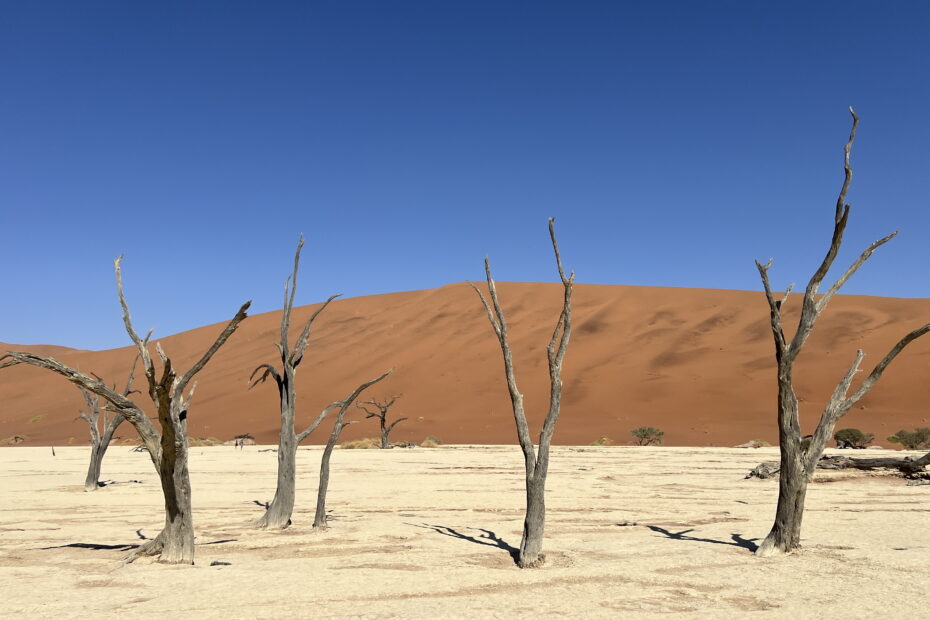All four of us went on a three-week road trip in Namibia from Fish river to Etosha national park in the summer of 2024, and loved it.
Like many others, we rented a 4×4 Toyota HiLux with rooftop tents, and drove a large circle from Windhoek via the Kalahari dessert to Fish river canyon and all the way to Aussenkehr and Orange river, where we canoed. From there we headed north through the Namib dessert via Naukluft mountain zebra park to Sesriem and the famous dunes at Sossusvlei. Further north we passed Spitzkoppe and Damaraland, visitied himbas in Kaokoland and reached the Epupa falls on the Kuene river that defines the border with Angola, where we rafted.
On the last part of the journey we drove south into Etosha national park to experience elephants, rhinos, lions and the many other species of wildlife that roam the waterholes during the dry Namibian winter.
Planning and preparation
We used the Bradt guide for Namibia and travel blogs as the primary sources for planning. We found that Camping in Namibia gave a good overview of campsites, but the website is not as easy to use as for example booking.com. We joined Facebook groups for Namibia travelers, where many are ready to help answering questions. It seems that campsites in the popular national park like Etosha and Sossusvlei get booked many months in advance.
We bought a SIM card from mtc when we arrived in the airport. It is said to provide the best coverage for the country. We had coverage around cities, but not on the long drives between cities.
We could pay with credit cards practically everywhere we went. At some of the more remote campsites, they had asked us in advance to bring cash for payments. ATM’s are easy to find.
See here for our experience with Renting a Toyota Hilux 4×4 with roof tents and driving in Namibia.
T has celiac disease. Read here about our experience traveling gluten free in Namibia.
Day 1: Arrival in Namibia
We landed on a night flight in Windhoek, and as the first thing we picked up our 4×4 Toyota HiLux with rooftop tents from Bushlore. We received thorough instructions on how to fix punctures, dig out the car from loose sand, inflate and deflate tires. They had laid out all equipment on the ground around the car, and it was a part of the instruction that we placed the items in the car, so that we knew where it was and how to use it when needed. That worked well.
The car comes with kitchen facilities, a 60 liter water tank and 140 liter diesel tanks. We were equipped to be on our own for days. Namibia is sparsely populated with remote areas. It felt like starting a small expedition, and an adventure.
We had brought summer sleeping bags from home, and used them. The car comes with sleeping bags, and on the cold nights, we used both to stay warm.
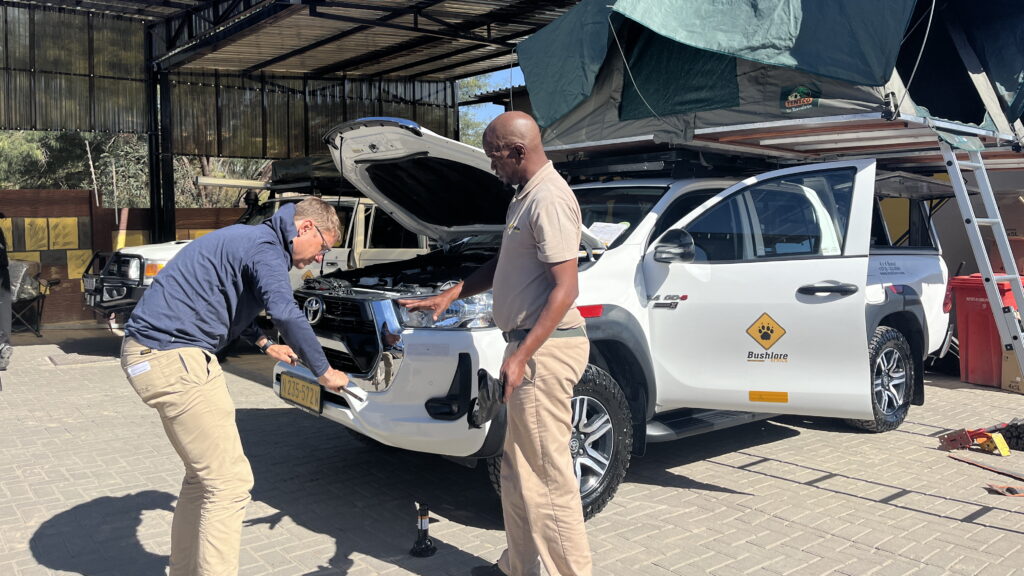
We headed to a Spar supermarket to buy groceries. The selection is reasonable, but smaller than we see in Denmark. We found the vegetables and other essentials that we needed. But the selection of gluten free products was very small, and we were happy we had brought gluten free pasta, bread, snacks and dehydrated meals for T from Denmark.
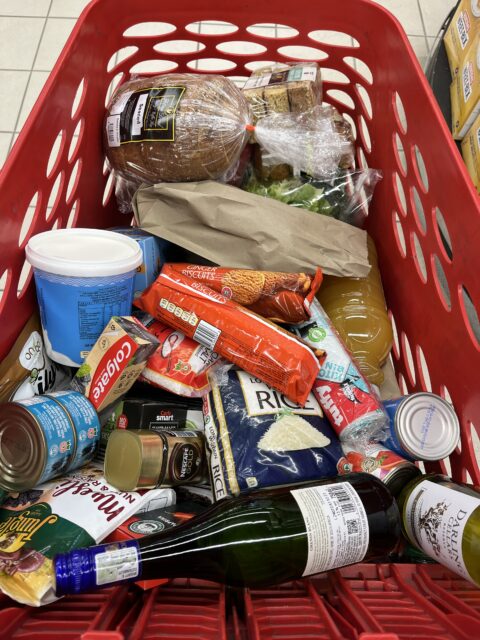
To be able to boil water quickly and easily, we had bought a JetBoil. It requires a threaded gas canister, and we tried our luck in three different outdoor shops, but unsuccessfully.
The drive from to Immanuel Wilderness Lodge just outside Windhoek was a first introduction to Namibia’s landscapes. The lodge offered a peaceful retreat, perfect for recuperating from our 27-hour journey. We enjoyed a quiet evening, planning the days ahead. The owner Natasja gave a lot of useful tips and recommendations.
Day 2: South to Kalahari Anib Lodge
The three-hour drive south to Kalahari Anib Lodge introduced us to Namibia’s desert scenery, with endless horizons. Upon arrival, we learned that due to overbooking, our campsite reservation had been upgraded to rooms at the lodge for the first of the two nights. This turned out to be a blessing, as it allowed us to relax at the pool, go for a run, and observe the springboks and eland antelopes at the lodge.
Day 3: Kalahari dessert and the San People
Our morning began with a bushwalk guided by the local San people (sometimes called bushmen), the original inhabitants of southern Africa. They showed how they could live with the natural resources of the desert, and introduced us to their unique click-sound language.
We visited a small San settlement that has been built on the land of one of the lodges, to showcase San culture to tourists. The San no longer live in the Kalahari. Decades ago they were moved to the north of Namibia by the government.
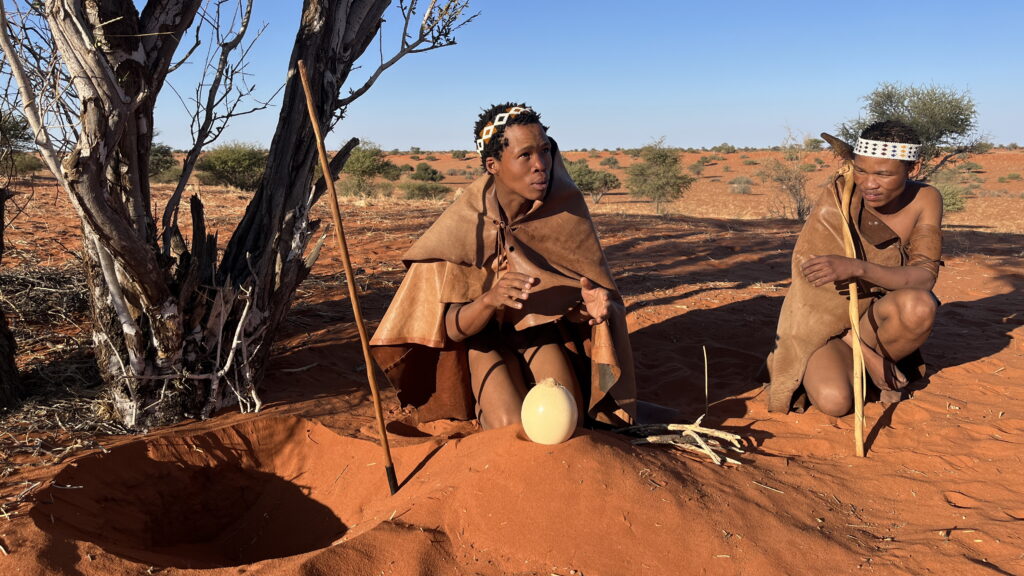
Back at Kalahari Anib Lodge, we checked into our campsite. We unfolded the tents for the first time, and got organised with our stuff in the car. It was windy, and the wind grabbed one of the tents, and smacked it closed with a bang. Luckily, nothing was damaged, and we learned to respect the strong winds of Namibia.
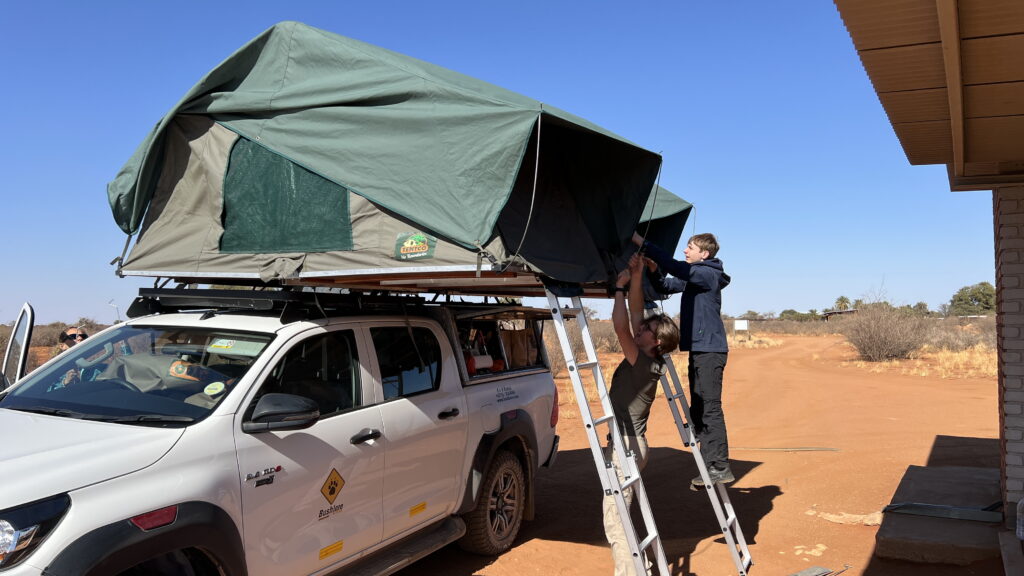
In the afternoon, we went on a nature drive with Moses from Kalahari Namib lodge. We saw ostriches, giraffes, zebras, and a variety of bird species, in particular the social weavers and the nests they build. The highlight was watching the sun set over the red sand dunes of the Kalahari dessert, casting a golden glow over the landscape. We were treated with snacks and drinks for a traditional southern African sundowner.
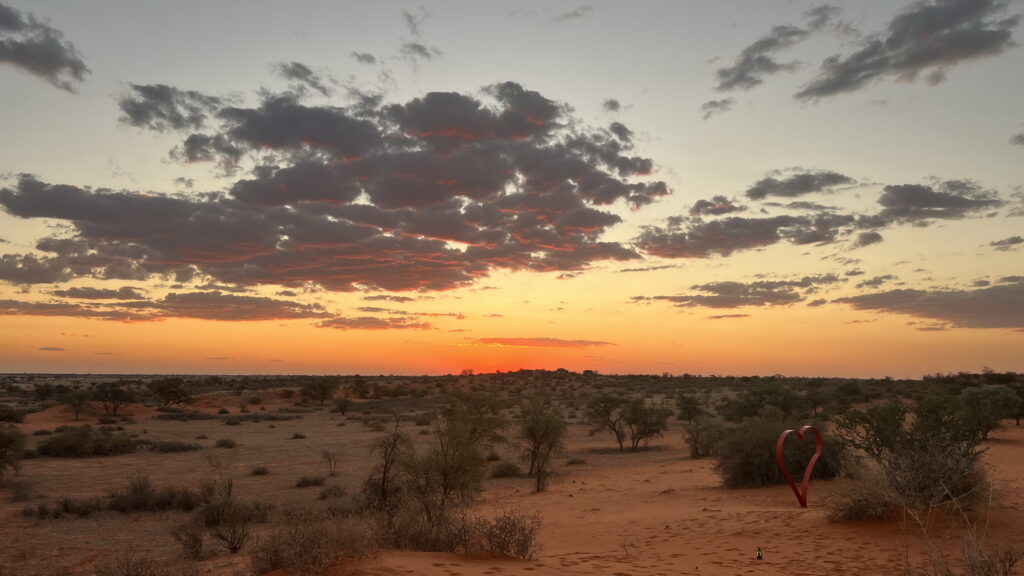
The camp sites at the lodge are far apart. We cooked dinner under the stars.
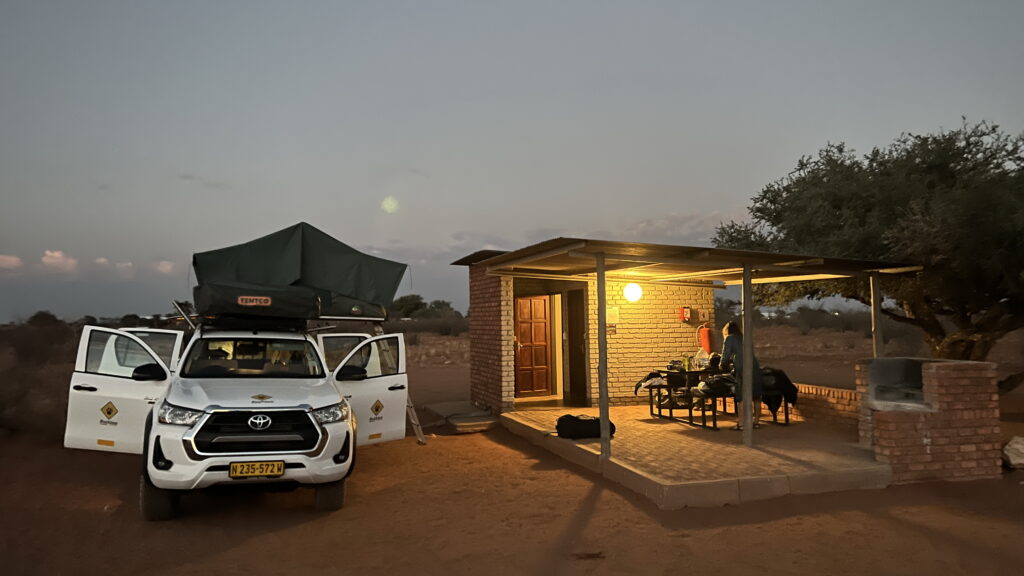
Day 4: Quiver Tree Forest and Giant’s Playground
We hit the road early, as we had a long drive ahead of us. Outside Ketmanshoop we explored the Quiver Tree Forest, a surreal collection of aloe vera trees unique to southern Namibia. These trees, with their distinctive silhouettes, created a dreamlike landscape. This forest and a similar in South Africa are the only places with many trees growing near each other.
Nearby, Giant’s Playground, a maze of scattered boulders, was an intriguing place to explore. We climbed around on the rocks and did a small hike in the area.
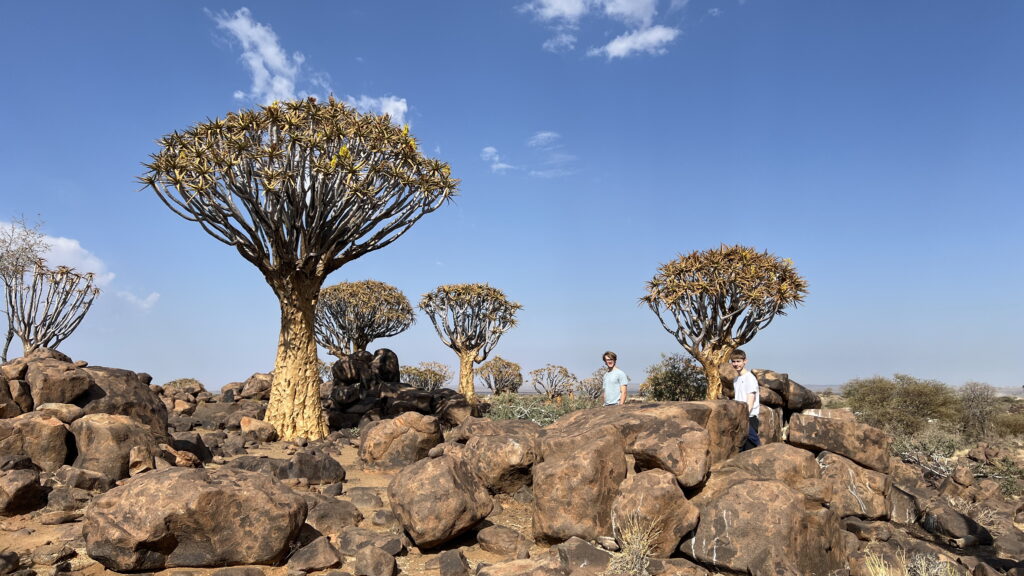
By late afternoon, we reached NWR Ai-Ais campground at Fish River Canyon. The hot springs-fed pool provided a relaxing end to the day. While we cooked, we saw a group of baboons approaching a nearby car. We rushed over, but they managed to open the trunk of the car, the refrigerator, and get away with food before we were there. This would not be our last baboon encounter.
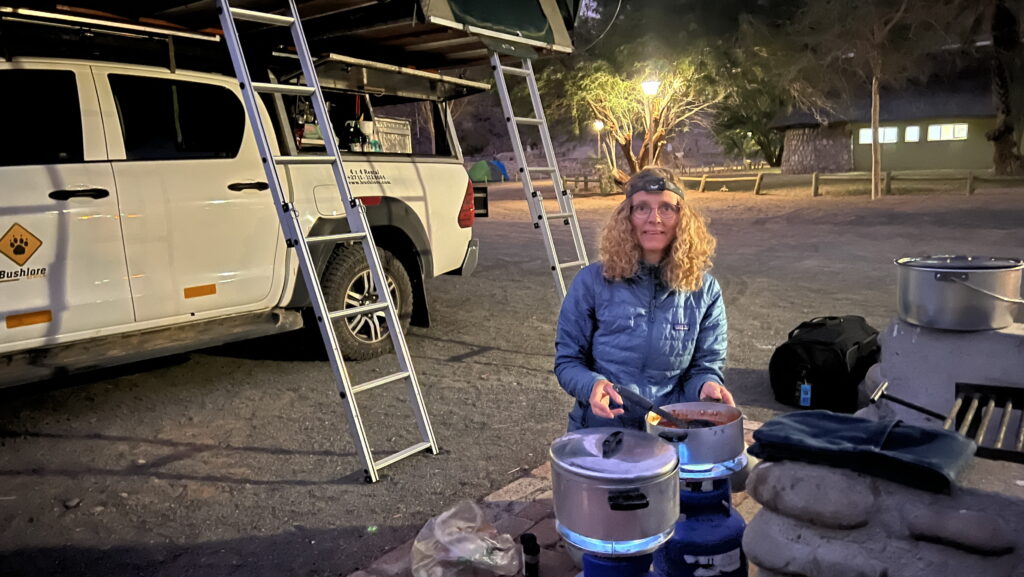
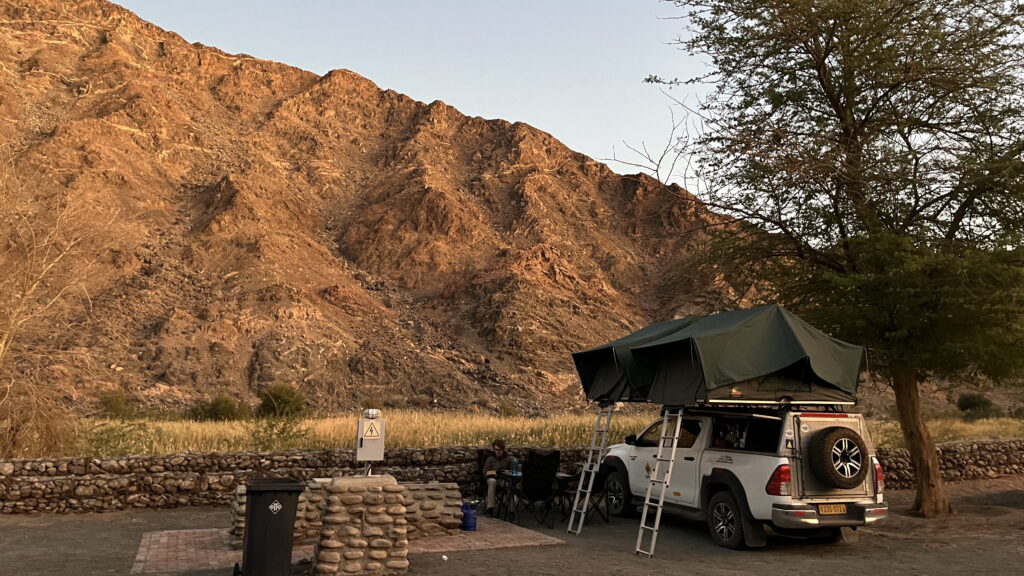
Day 5: Fish River Canyon
Helle and Peter started the day running on the Fish river canyon trail while a breathtaking sunrise unfolded across the Fish River Canyon. July is winter, and the river was almost dry, which makes winter the hiking season for the trail. It remains a dream for us to hike the five-day trail through the canyon.
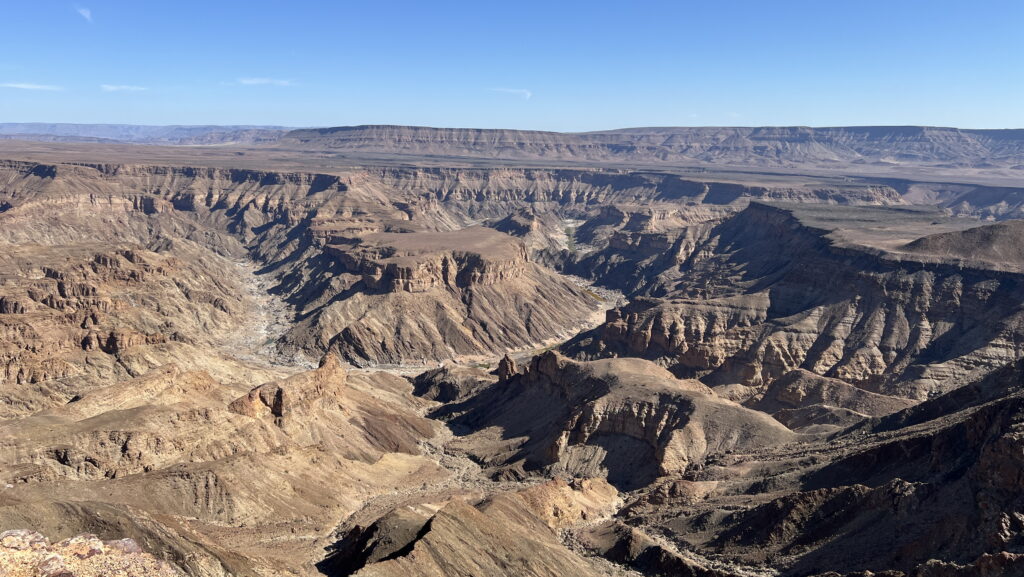
Post-run, Helle did her yoga and we spent the rest of the day exploring the canyon’s viewpoints. From Hobas there are 4×4 trails by the rim of the canyon, among the largest in the world. Fish river canyon is approximately 160 km long, 550 m deep, and up to 27 km wide.
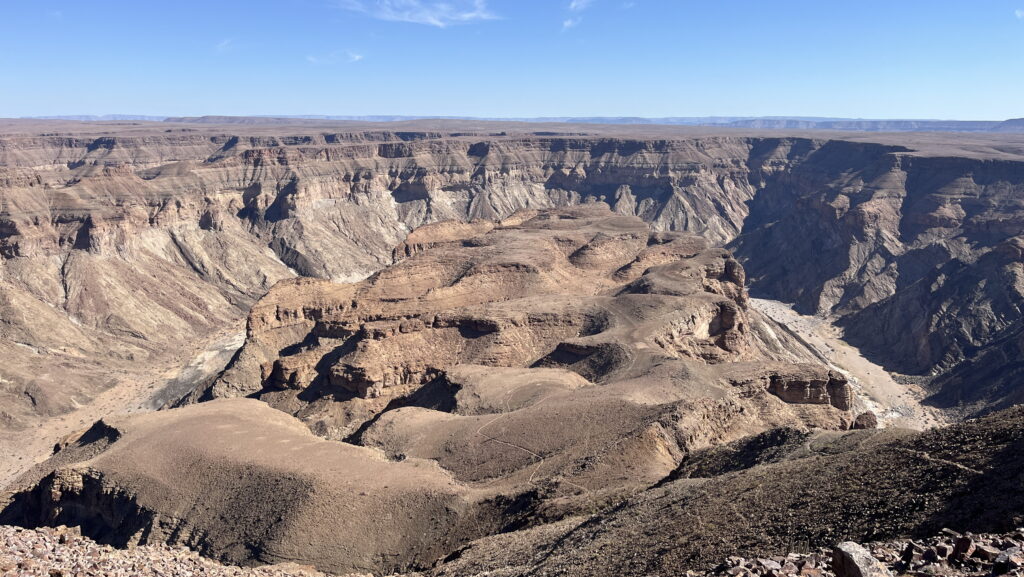
We drove to hiker’s viewpoint and also took the 4×4 road a bit south towards the Sulphur springs viewpoint. The horseshoe bends in the area of the main viewpoint are great places to have views to the bottom of the canyon.
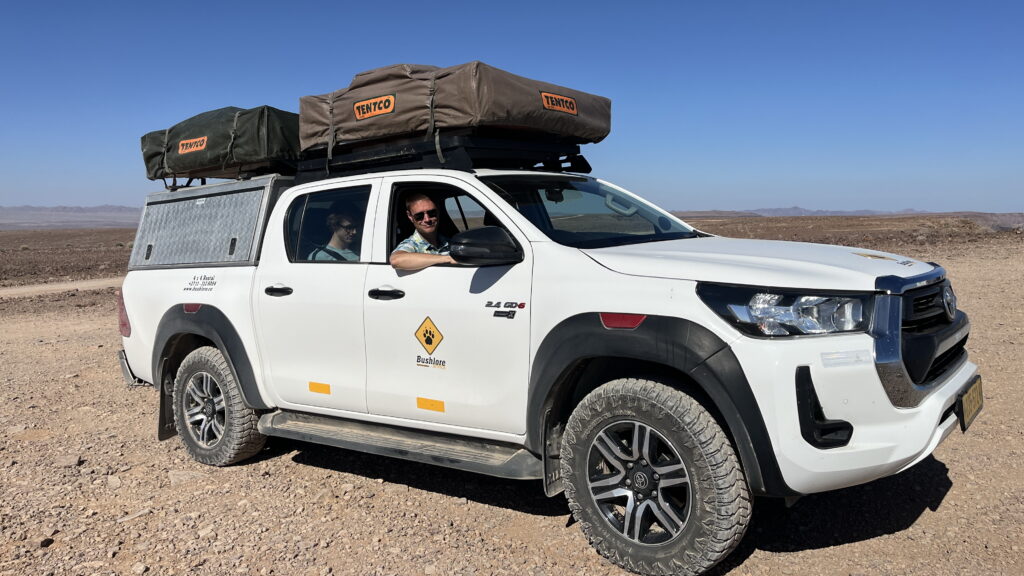
The dramatic rock formations and the canyon’s immense depth is impressive. Lone quiver tress add to the scenery.
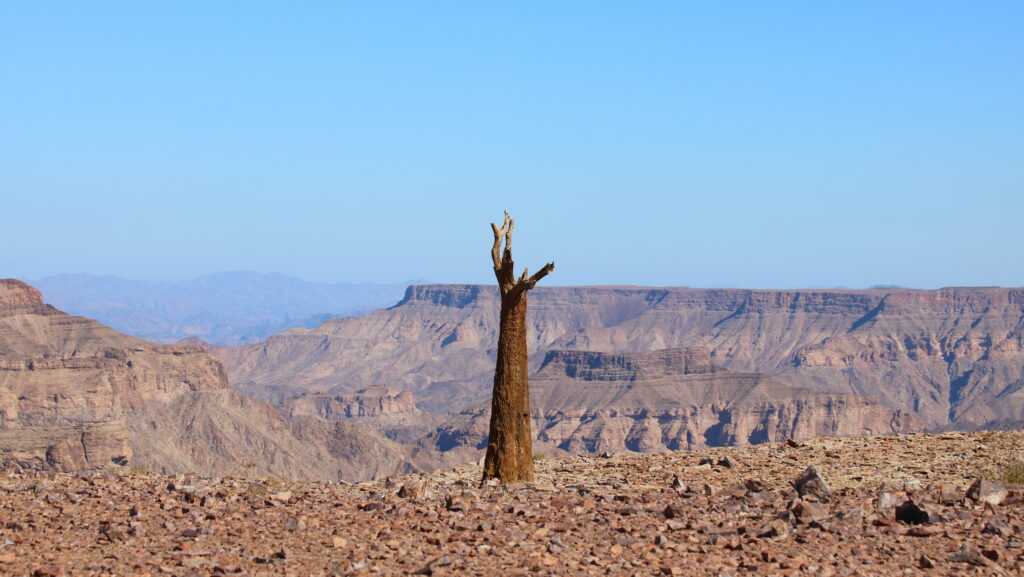
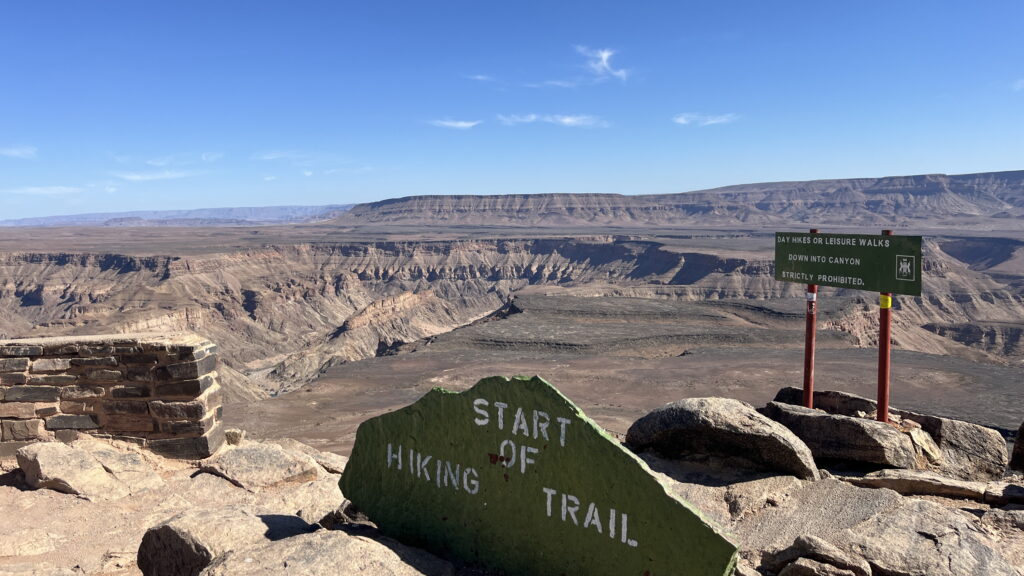
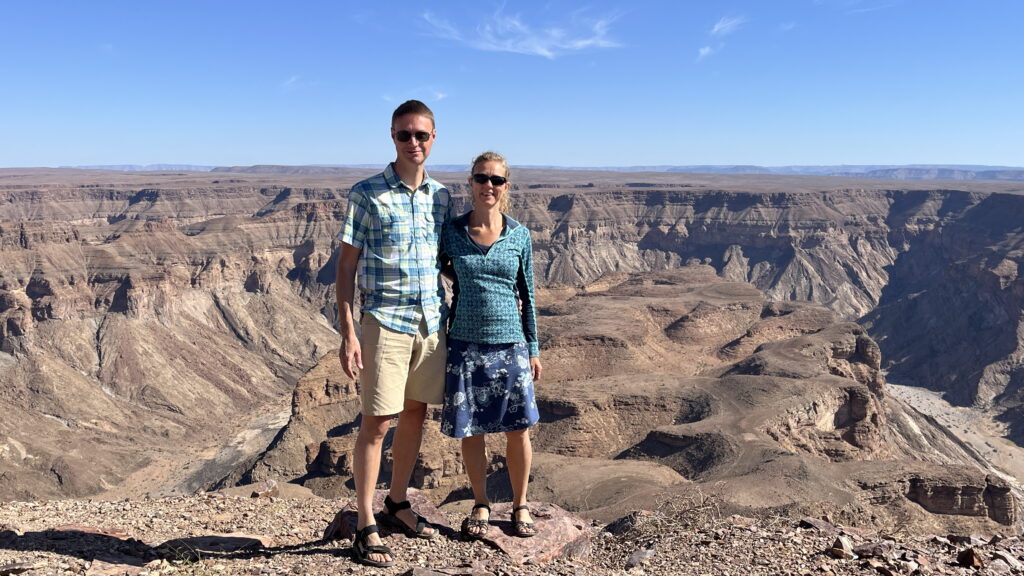
The evening brought another display of stars, the Milky Way stretching across the sky in a clear, unpolluted view.
Day 6: Canoeing on the Orange River
We left the Ai-Ais campsite and drove further south. The gravel roads and dusty, hilly landspaces continued, but without any feeling of monotony. We saw only very few other vehicles, and it felt like adventure to drive this far into remote Namibia.
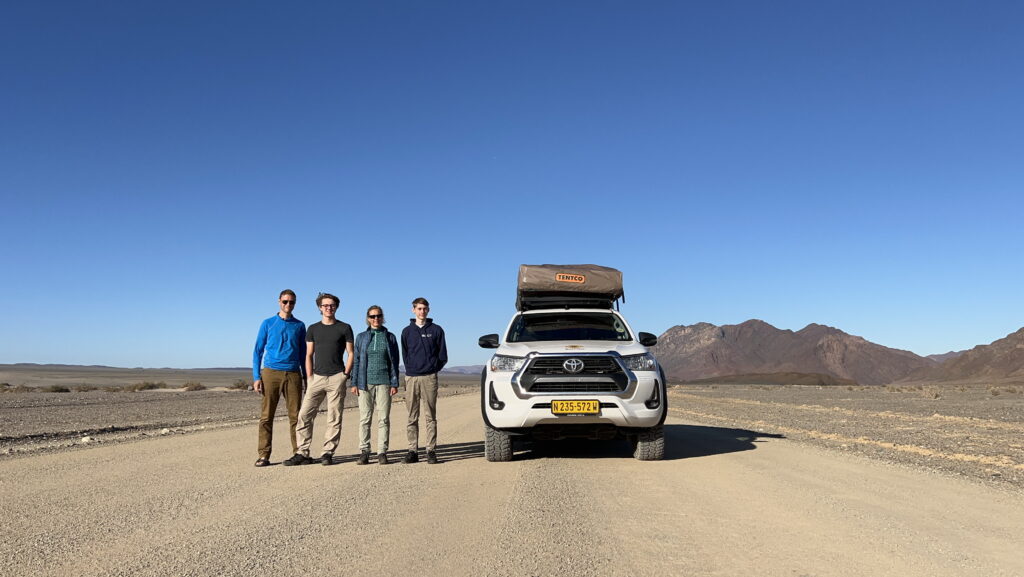
We made our way to Aussenkehr. We stocked up on groceries at the Spar supermarket. Most of the other people in the shop left with a 25 kg bag of maize meal as the only item. We filled our cart with basic supplies for the next days, and left with the awareness of how privileged we were to be able to afford fresh vegetables.
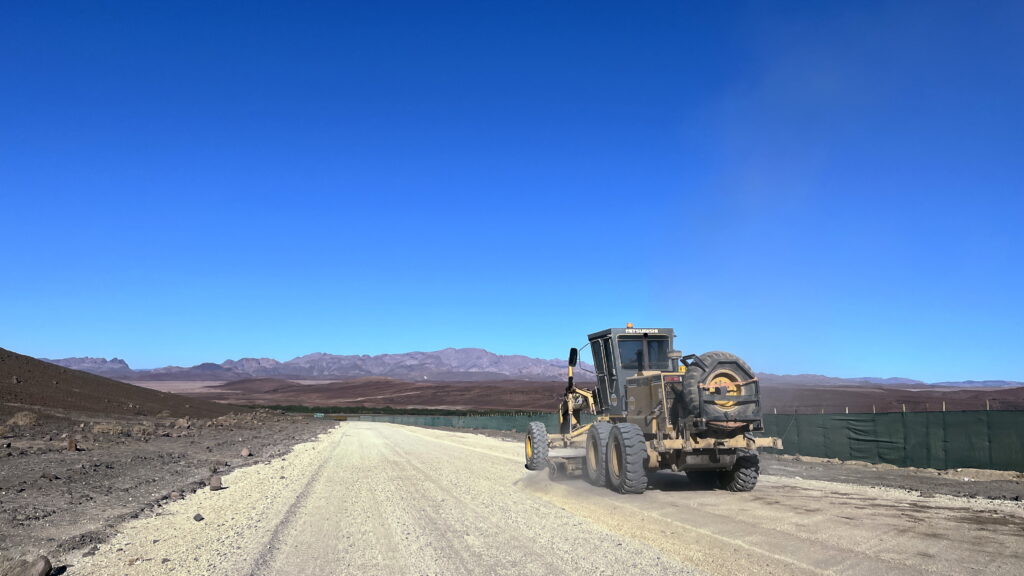
Aussenkehr is situated on the banks of the Orange River at the border with South Africa, and the river was our reason for coming. After checking in at Norotshama River Resort, we were ready to embark on a guided canoe tour, booked many months prior. But the guide, Anthony, had a day off, and the car had a broken windshield. There was nothing to do about it, but we had come here to canoe and would have changed plans if we knew. Then, 15 minutes later Anthony came. Having heard our story he decided to spend his day off canoeing with us. He and the driver decided they could take the car for the short drive to meet us down stream to pick up and return the canoes later.
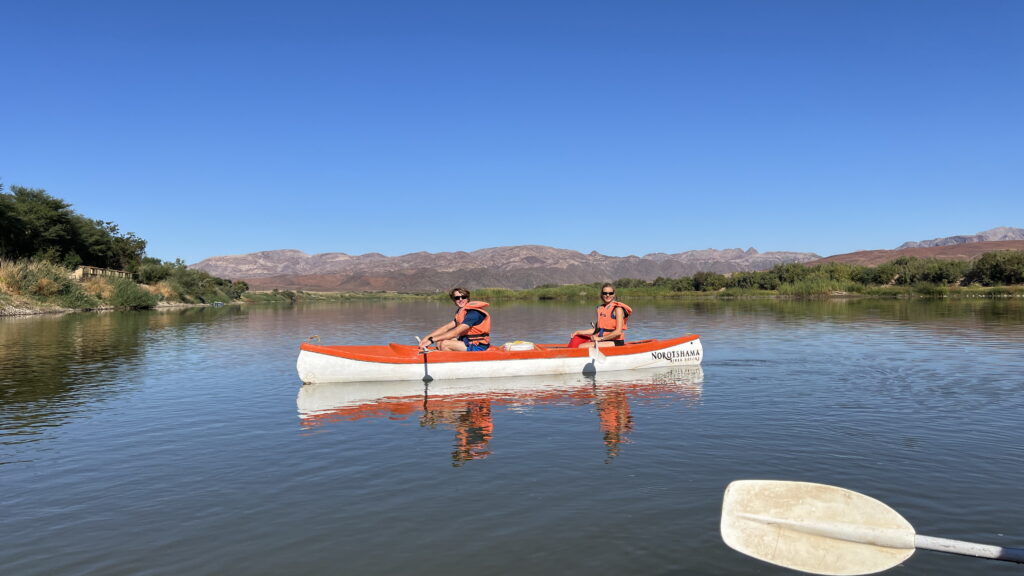
We were thankful and happy, and quickly found ourselves paddling gently along the river’s calm waters. Anthony shared fascinating insights about the local grape cultivation, a major industry in this arid region. He was knowledgeable about Namibian politics, and optimistic about the future of his country. Despite the wind picking up later in the day, we enjoyed the tranquility and beauty of the river. As the sun set, casting a warm glow over the water, we decided to have dinner in the resort’s restaurant to fully enjoy the view.
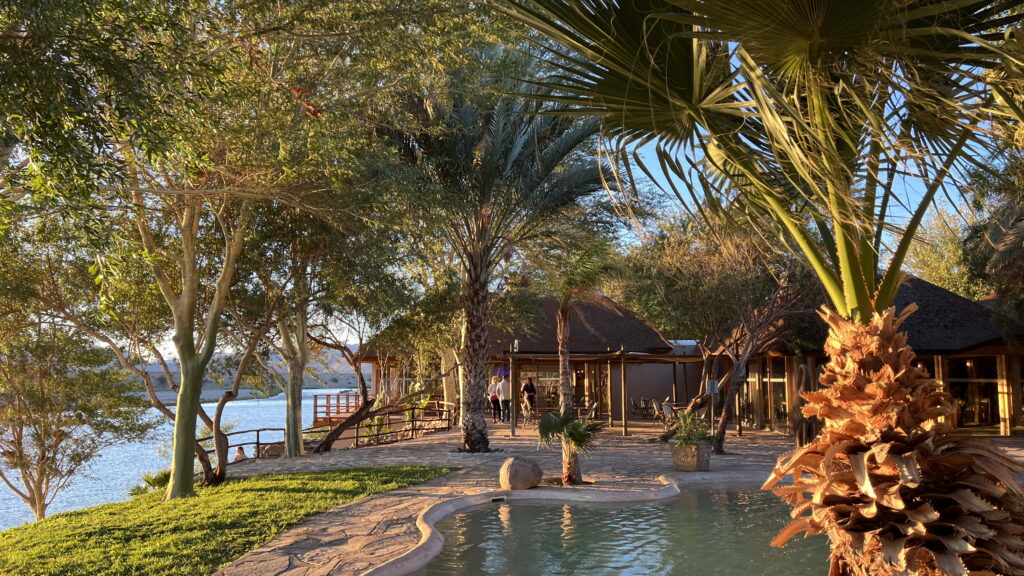
Back at our campsite, we made a campfire and again enjoyed the quiet starlit night.
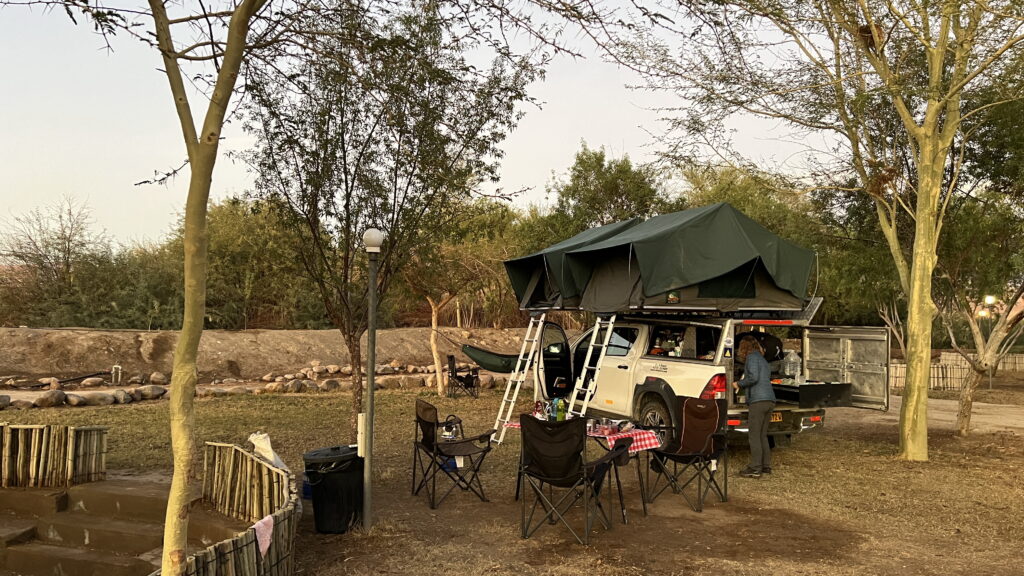
Tobias decided to sleep in his hammock, so he set it up as we got ready to go to sleep.
Day 7: The Milky Way at Kanaan Desert Retreat
Our journey continued along the scenic Orange River. This part of the country felt particularly remote, and we met very few other cars. We made a stop at the gas station in the mining town of Rosh Pinah.
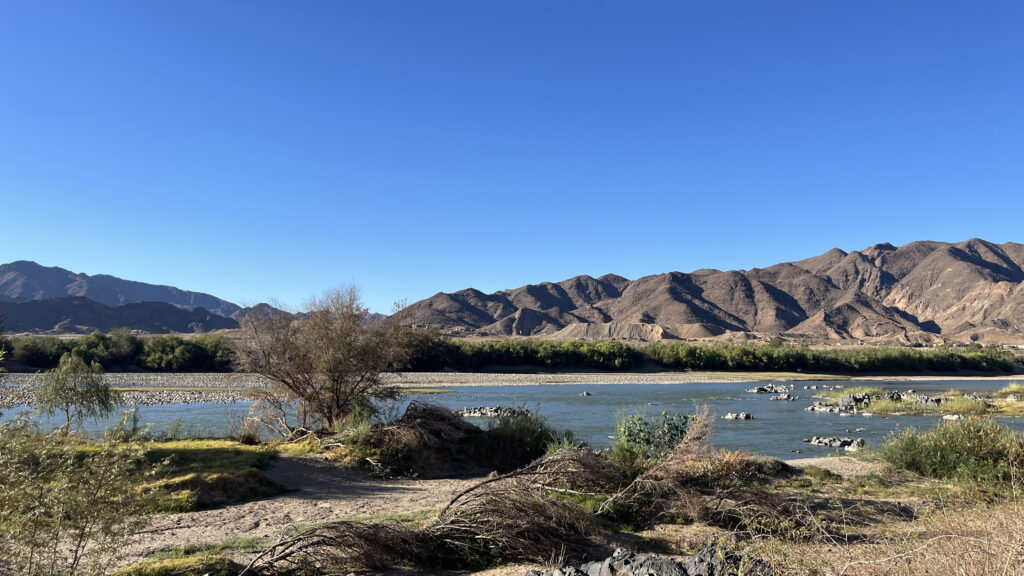
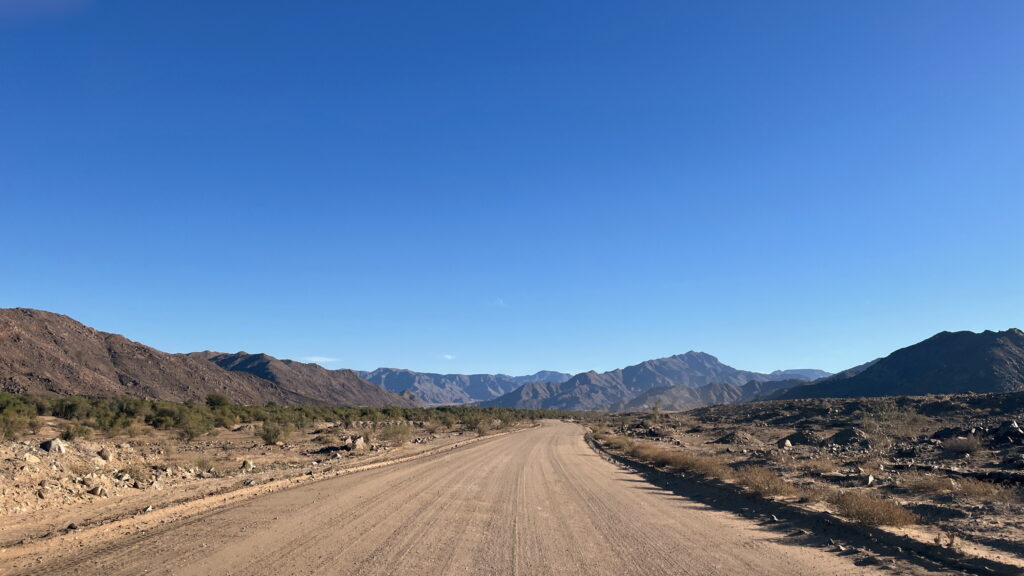
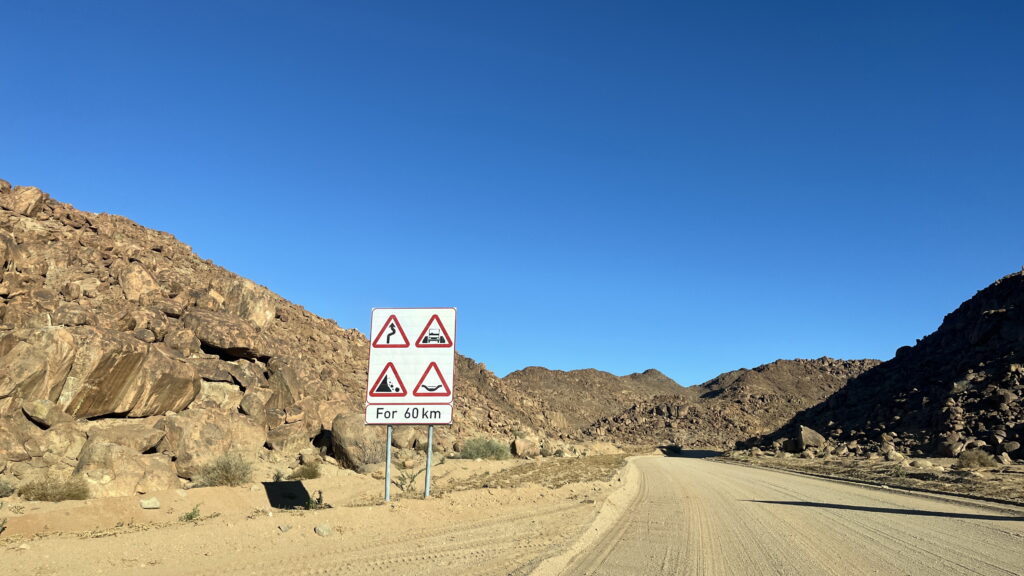
In Aus we made a small detour to the nearby lookout where we saw the wild horses of the Namib desert, believed to be descendants of German WWI cavalry horses.
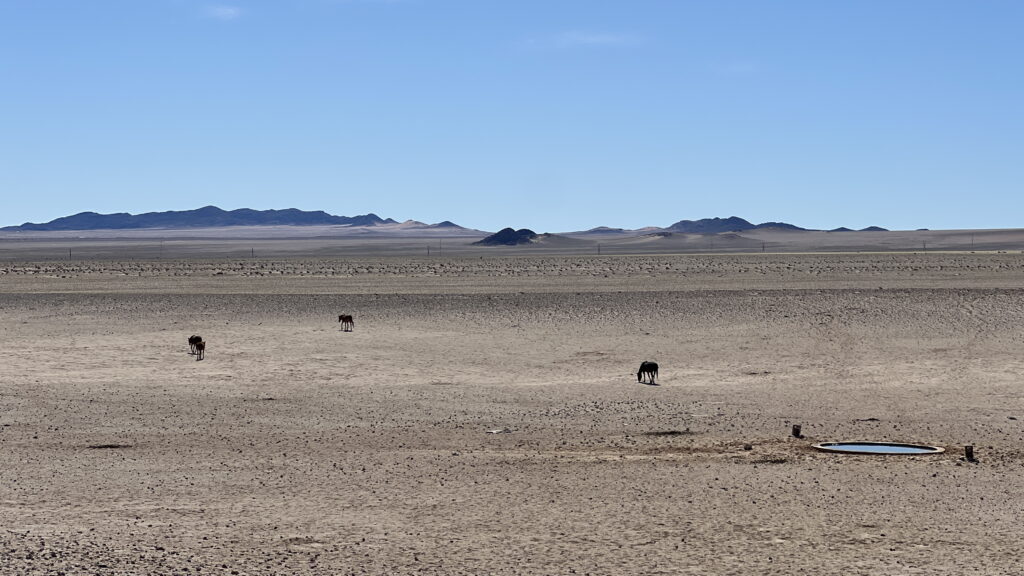
North of Aus, we turned left onto the D707 road, which is considered particularly scenic. It follows the edge of the Namib national park. We saw oryx antelopes and other animals from the road.
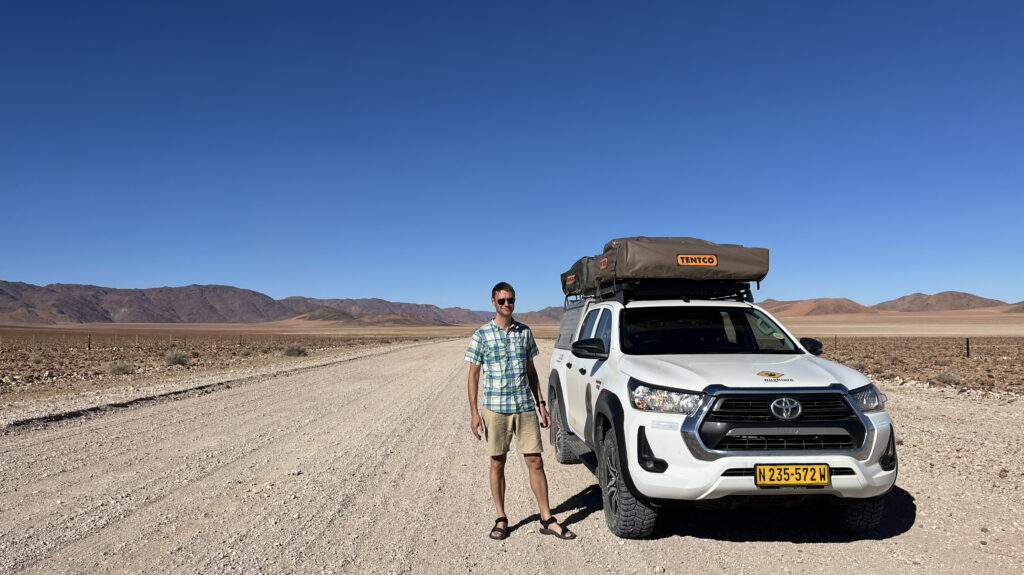
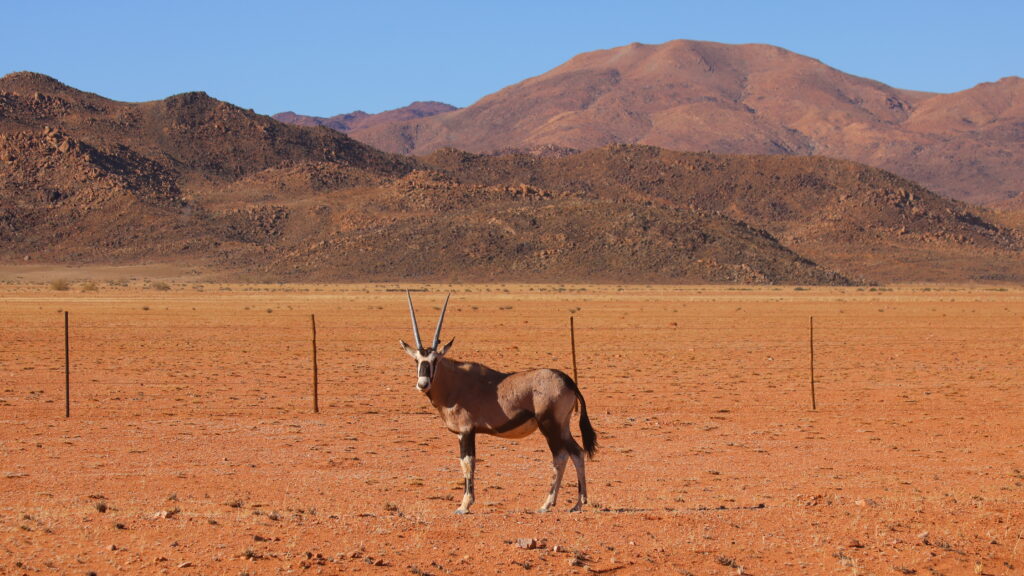
Arriving at Kanaan Desert Retreat, we were taken back by the vast, untouched desert landscapes. T took a run, while Helle and Peter went for an evening walk, enjoying the peace and quiet. Kanaan Desert Retreat has eight campsite set far apart with uninterrupted views of the desert.
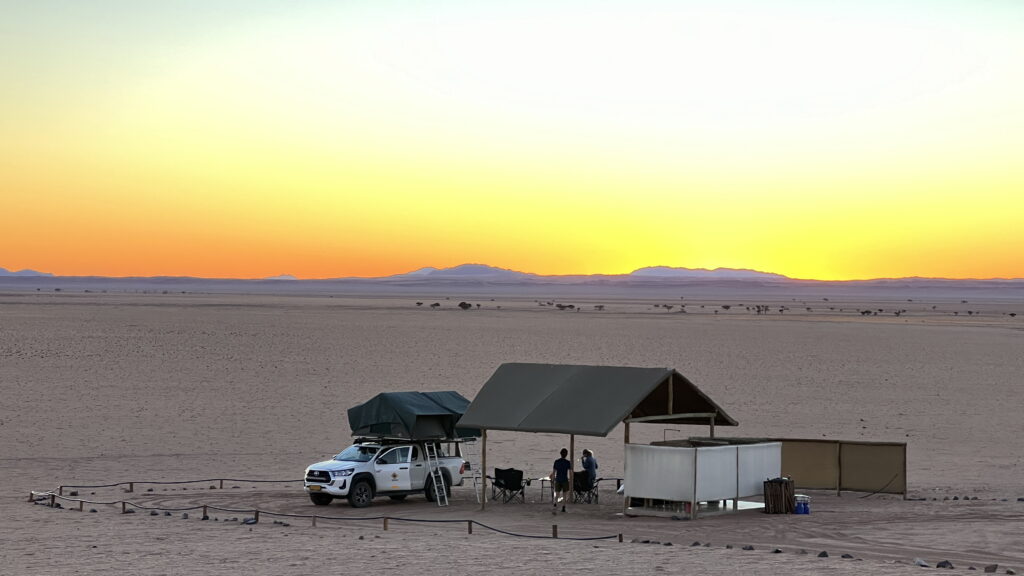
The day ended with a spectacular desert sunset that painted the sky in shades of pink and orange. As sunset turned to night, we were treated with the most brilliant starlit night of the trip. There was no moon or electric light pollution, and the Milky Way was an amazing view. T believed it was the first time in his life, that he really saw the Milky Way.
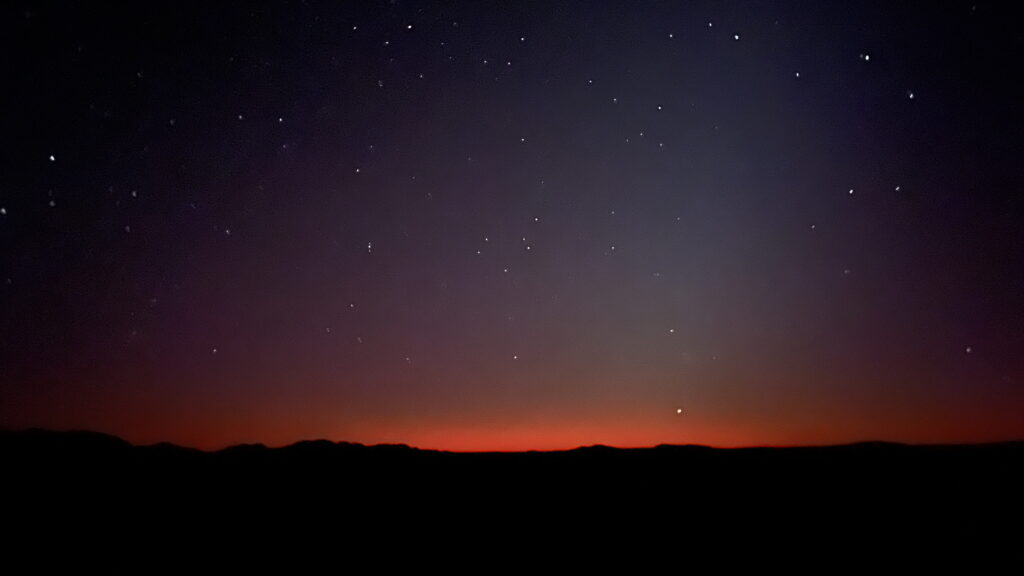
Day 8: Sesriem Canyon and Elim Dune
Further north we were back on the larger C27 road as we made our way to Sesriem, the small village that serves as a base for visiting the famous dunes at Sossusvlei and Deadvlei.
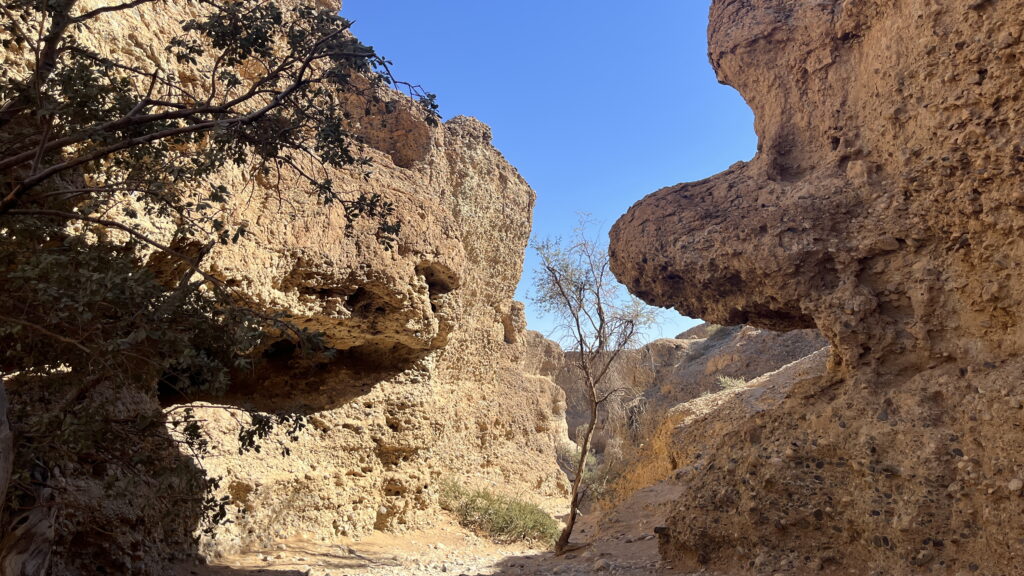
We checked in at the NWR Sesriem campsite, and after setting up camp, we visited the remarkable Sesriem Canyon, a deep, narrow gorge carved by the Tsauchab River.
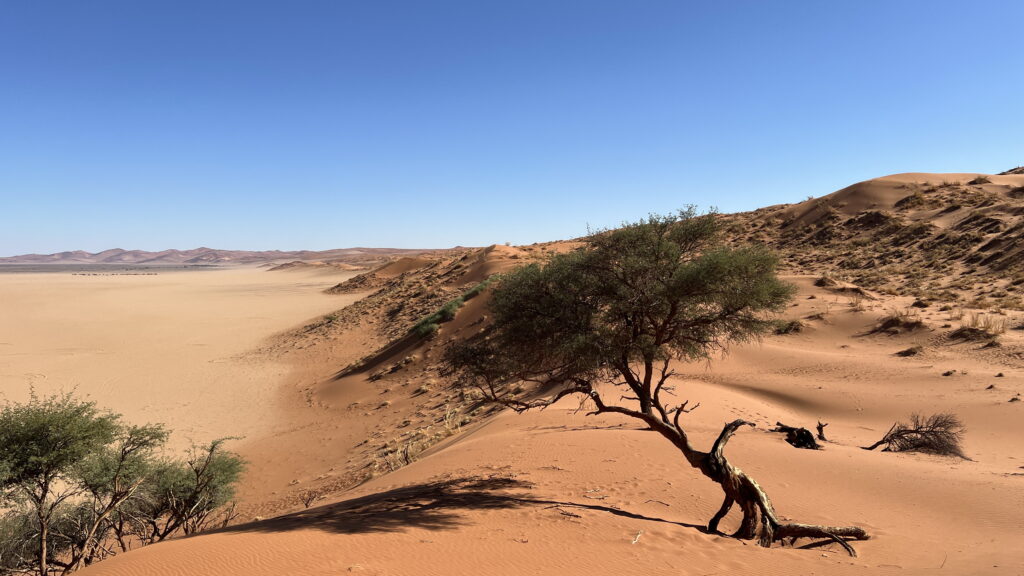
On our way back to camp, we made a stop to climb Elim Dune in the late afternoon. We were rewarded with panoramic views of the surrounding desert. The afternoon was warm, and back at the campsite, we cooled off by the pool.
The winds were strong throughout the two days we stayed at Sesriem, and with sand in the air, it was a bit rough.
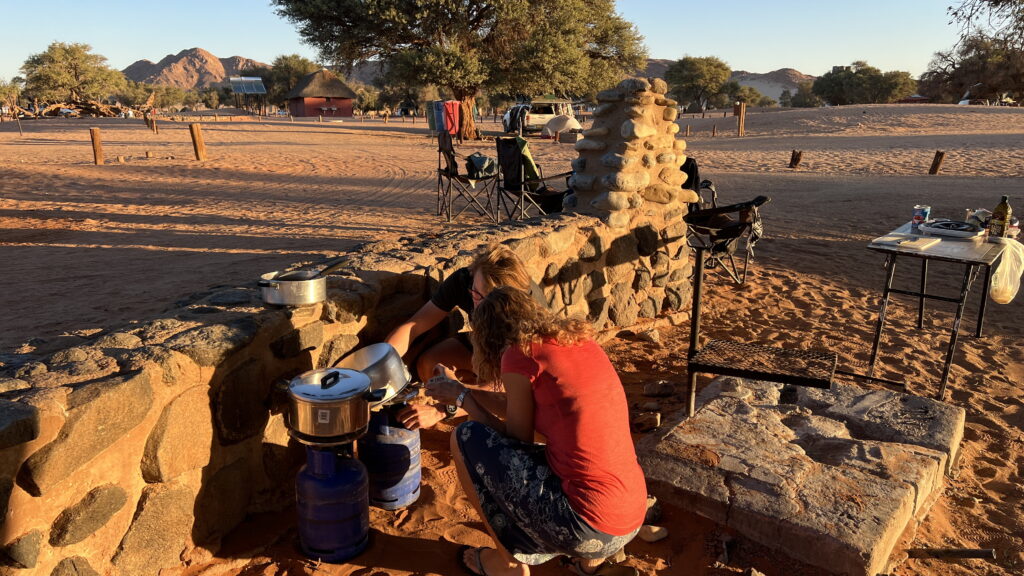
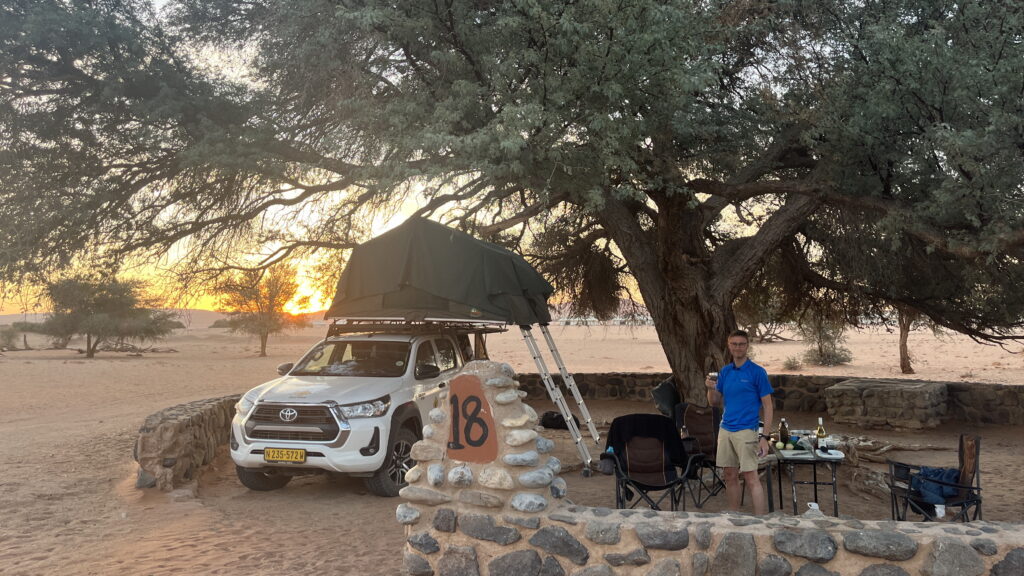
Day 9: Deadvlei in Namib-Naukluft National Park
Many start early on the day they visit Deadvlei, to experience the sunrise there, and to start before the day heats up. But N preferred to sleep longer, so we stayed at camp until nine, and headed towards the dunes.
The road changes from gravel to soft sand on the last km before the Deadvlei parking lot. We decided to take the risk of getting stuck in the sand, and deflated the tires on the car. It was our first experience driving in soft sand, but it was easy enough, and fun.
Deadvlei, with its ancient, desiccated trees standing starkly against the white clay pan and red dunes, was a surreal sight. We spent the morning climbing the massive dunes and exploring this hauntingly beautiful area.
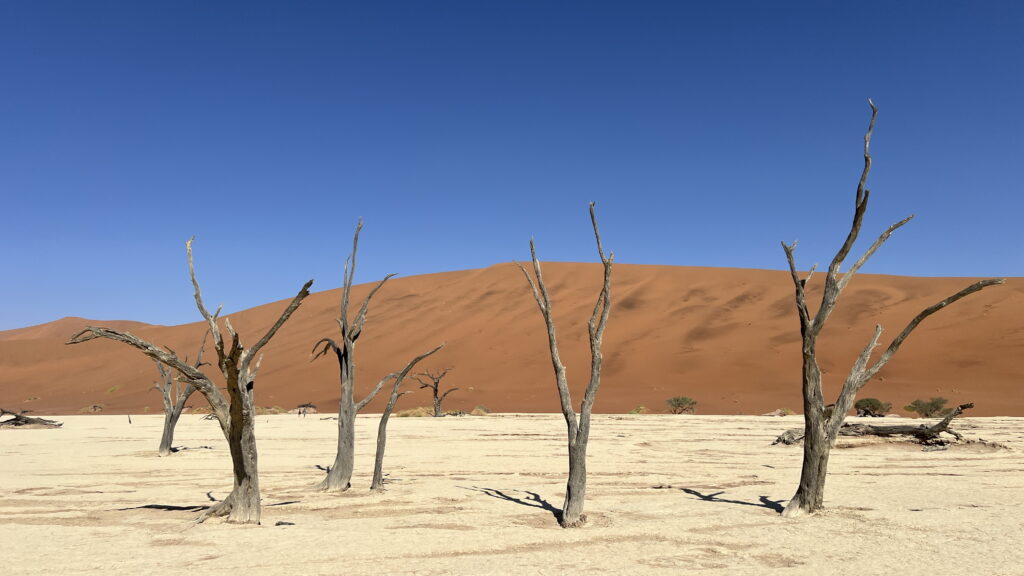
Deadvlei is surrounded by tall dunes, and we hiked up one of them to admire Deadvlei from above and have a sense of the scale of the dunes.
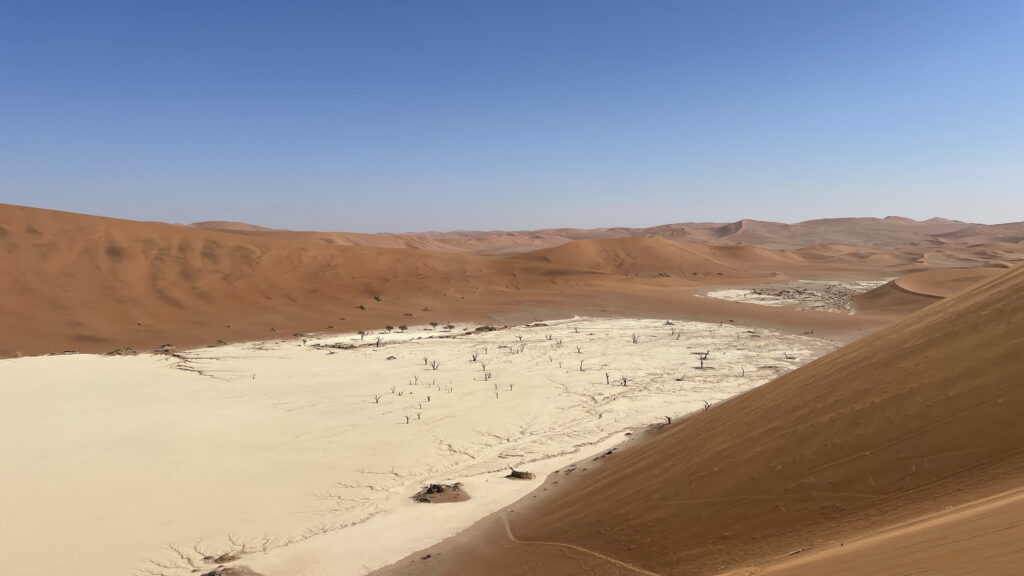
The wind persisted throughout the day. The temperature reached 30°C, but with the wind and low humidity, it did not feel hot.
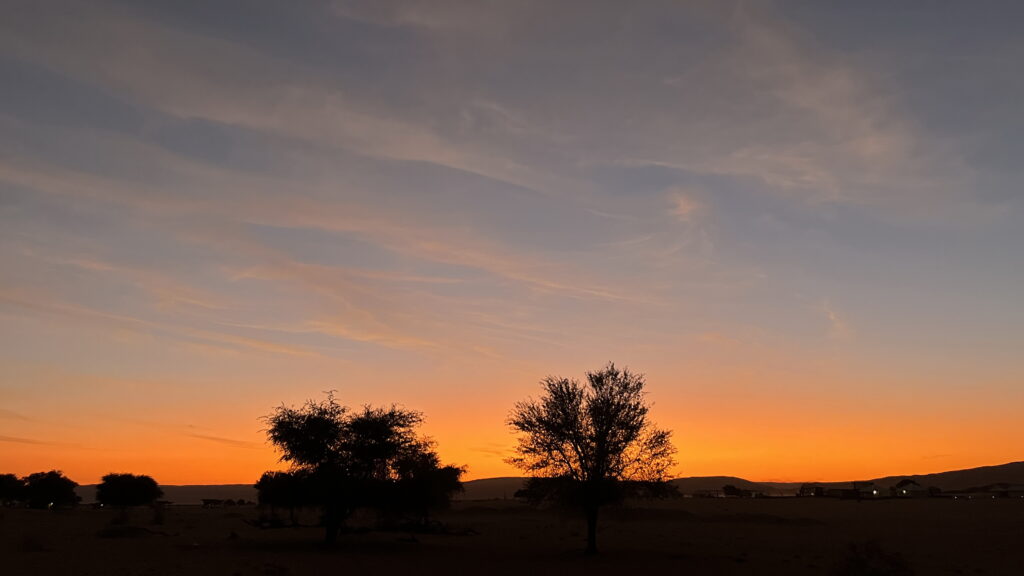
Day 10: Hiking in Naukluft Mountain Zebra Park
Naukluft Mountain Zebra national park was our destination for the day. The mountains reach up to 2000 metres, and that was a contrast to the dry desert landscapes we had seen until now.
It was chilly and overcast weather when we started hiking the 10 km Olive Trail in Naukluft Mountain Zebra Park. The trail took us through rugged terrain, climbing nearly 1900 meters above sea level.
Although we didn’t encounter any mountain zebras, the breathtaking views and diverse flora made the hike worthwhile. It is an easy trail, with one short but steep section, that is navigated with chains bolted in the side of the mountain.
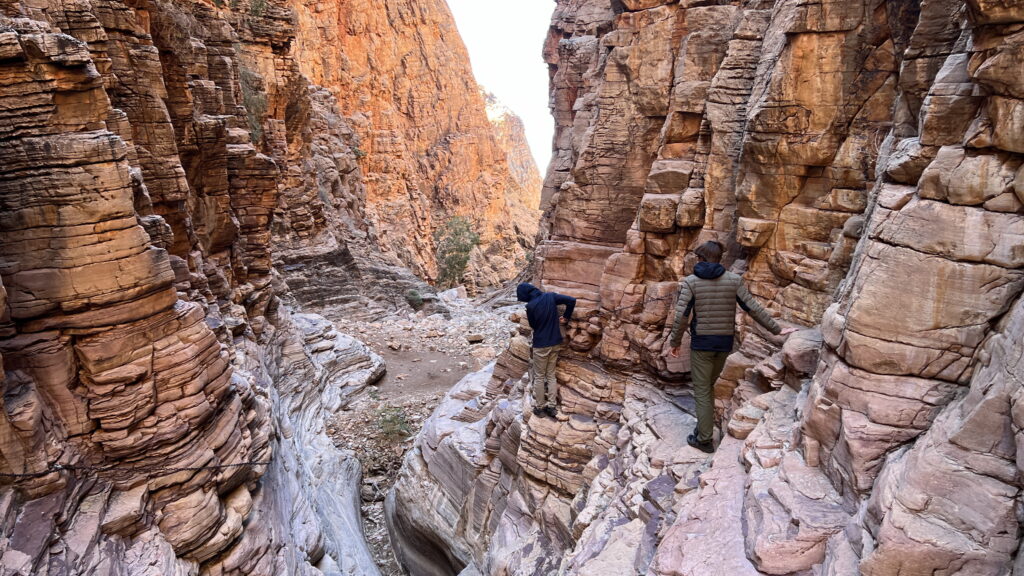
Back at the NWR Naukluft campsite, we had an unexpected encounter with baboons. The camp staff warned us about them, so we stayed close to the car.
For dinner we had leftovers from the previous day that only had to be heated. As we emptied the fridge, a baboon appeared out of nowhere. It dodged past Helle into the trunk of the car, and then jumped to the table next to Peter. The baboon grabbed the plastic bag with our dinner, and darted away. It all happened in seconds, and it was much too fast for us to intervene, and didn’t pay attention to our shouting.
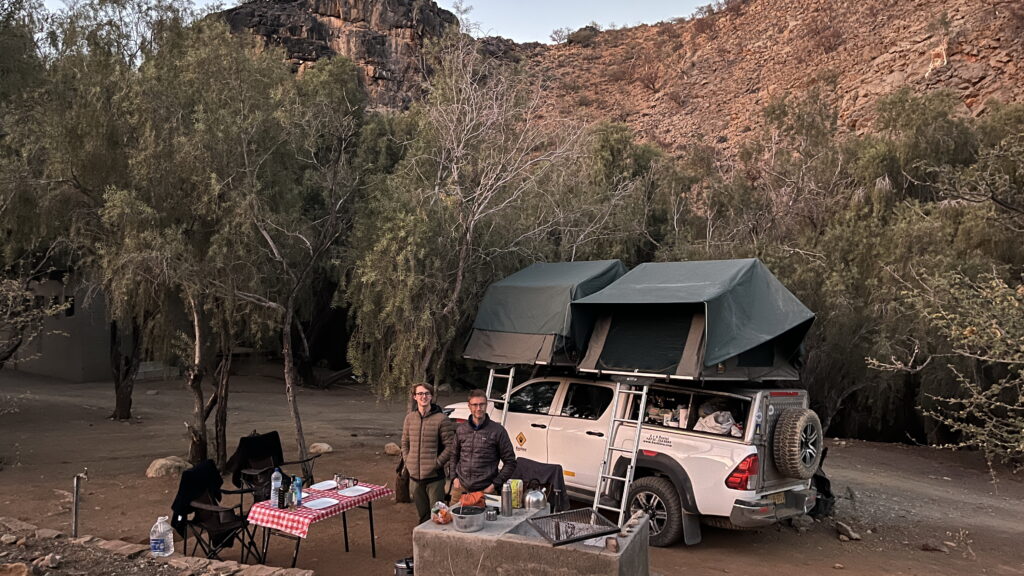
A Dutch family was at the camp site next to ours, and together with our boys they lined up around the camps with stones, to prevent the baboons from having an even larger feast. N caught sight of the perpetrator, who seemed to genuinely appreciate our cooking. That was a comforting thought.
Day 11: Solitaire and Swakopmund
The morning was cold, with frost on the tents as we foldes them onto the car. The car thermometer read 2°C as we left the camp, so we assumed it had been below zero during the night.
Leaving the mountains behind, we drove to Solitaire, famous for its bakery and delicious apple pie. And, there was a gas station.
The drive to Swakopmund took us through dramatic mountain passes and long stretches of monotonous desert. It was another beautiful drive.
Arriving in the coastal town of Swakobmund, we checked in at Rossmund lodge for three nights. We were happy with the comforts of our lodge—a hot shower and a cozy bed were luxuries after days of camping.
Swakopmund’s blend of German colonial architecture and African charm provided a cozy afternoon, and a nice dinner at Ankerplatz.
Day 12: Kayaking at Pelican Point
While Peter and N stayed at the lodge to relax, Helle and T joined a kayaking tour at Pelican Point. Paddling among hundreds of playful seals was a highlight, their curious nature making for an unforgettable experience. The seals enjoyed the company, and jumped up on top of the kayaks.
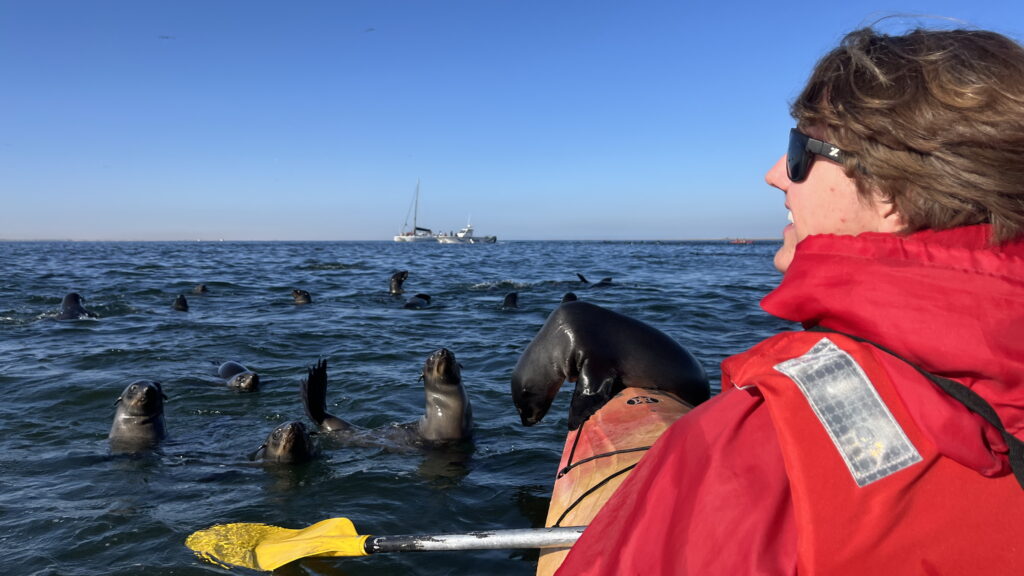
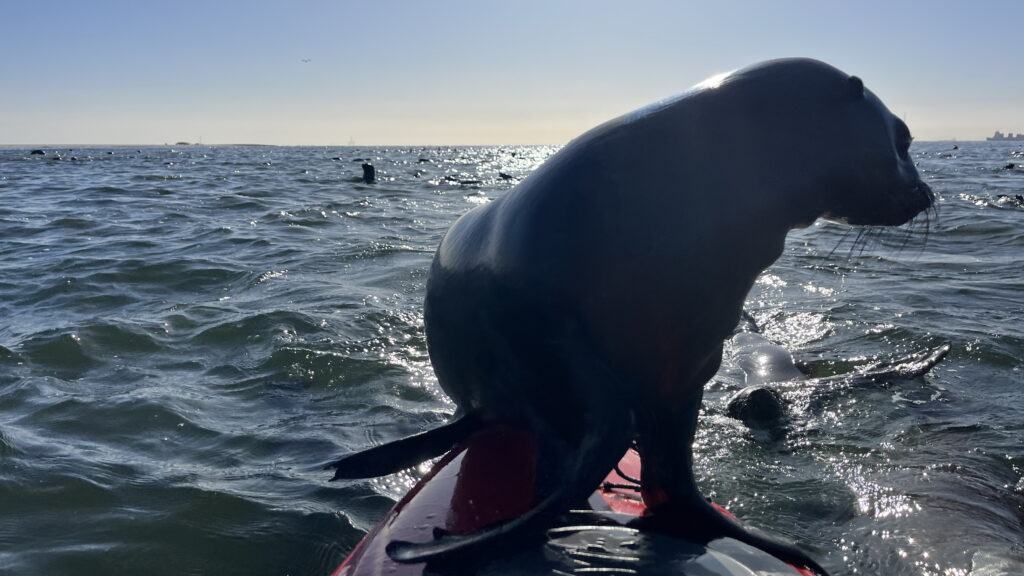
In the afternoon, we walked along Swakopmund’s seafront, the powerful Atlantic waves crashing against the shore.
Day 13: Quad Biking and Crystals
The desert around Swakopmund is a playground for adventure, and we went quad biking with Desert Explorer tours. N drove a quad bike for the first time. The boys had fun driving the quads across the dunes.
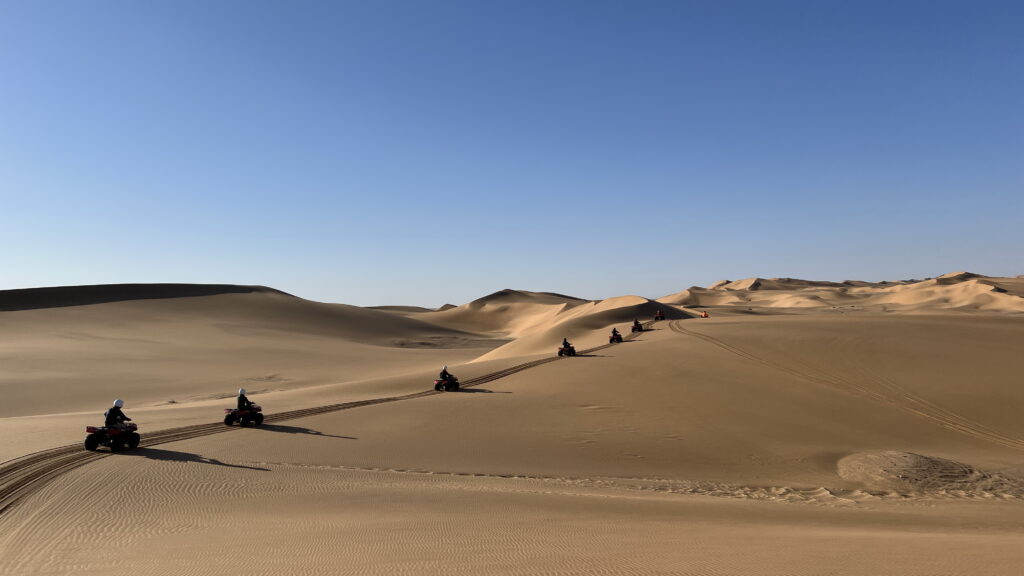
The guides looked for desert animals, and, we encountered a spider, a lizard, and a snake, all well adapted to the harsh environment.
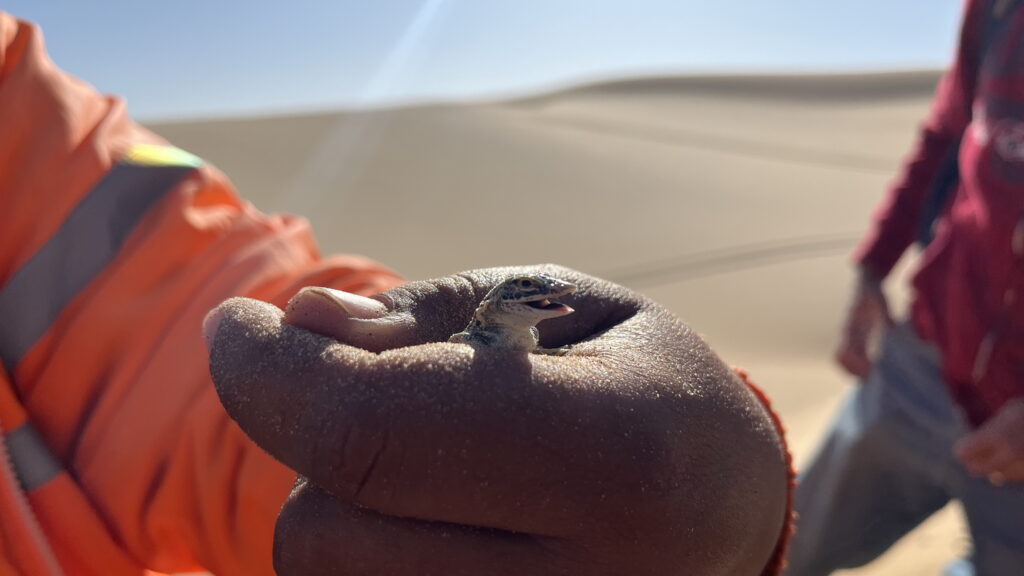
We ended our day with a round of mini golf and prepared for the return to camping life, looking forward to new adventures in Damaraland.
Day 14: Spitzkoppe and Madisa Camp
Heading into Damaraland, we stopped at Spitzkoppe, known as the “Matterhorn of Africa” for its striking red sandstone formations. The landscape was otherworldly, and we spent hours exploring the rock formations and ancient Bushman paintings.
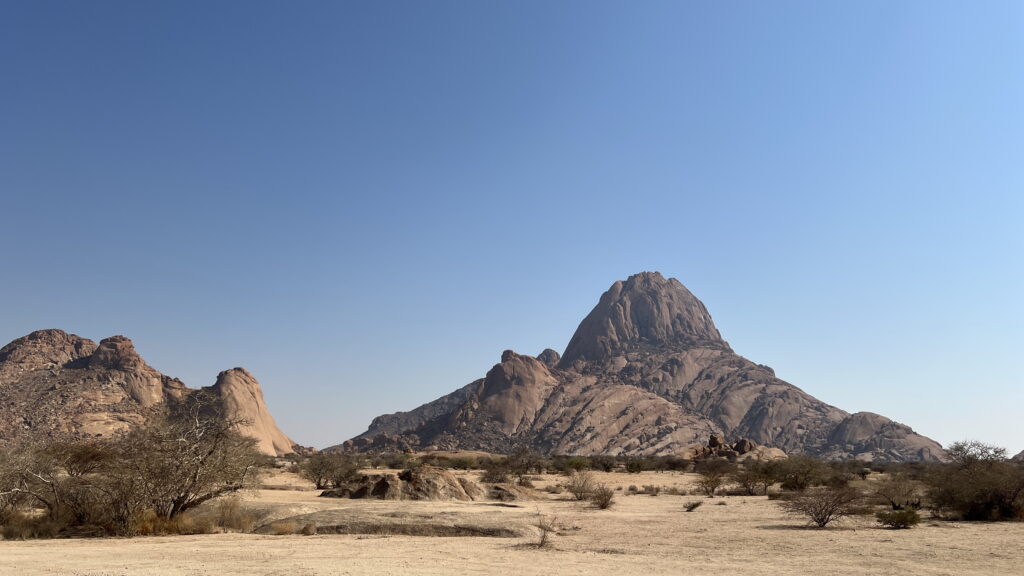
Our next destination, Madisa Camp, was nestled under towering cliffs on the brink of the Ugab river. We set up camp with the hope of spotting the desert elephants that sometimes pass through the camp on their way to the river. But the elephants were many km away. Instead we enjoyed the relaxed atmosphere around the pool.
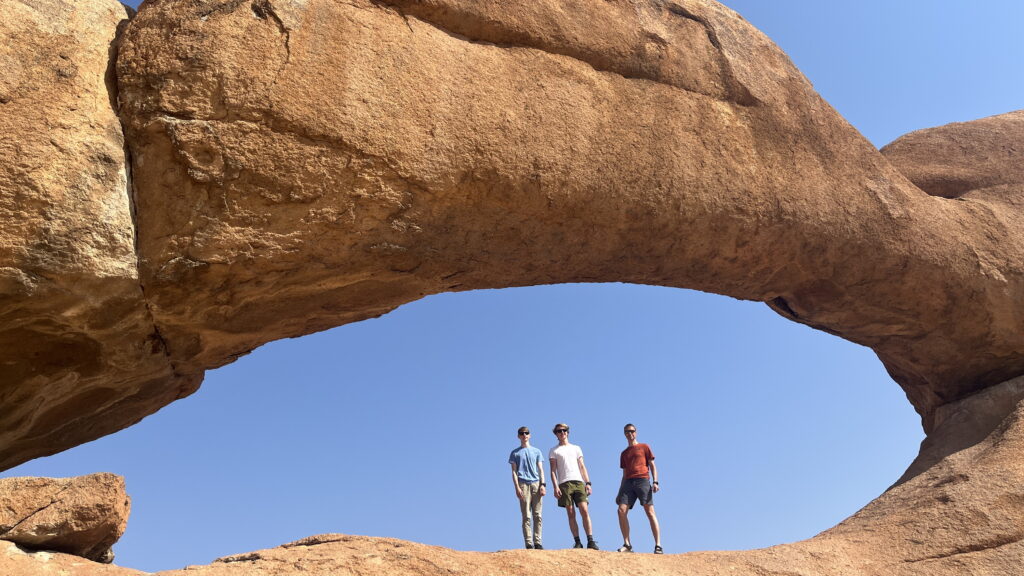
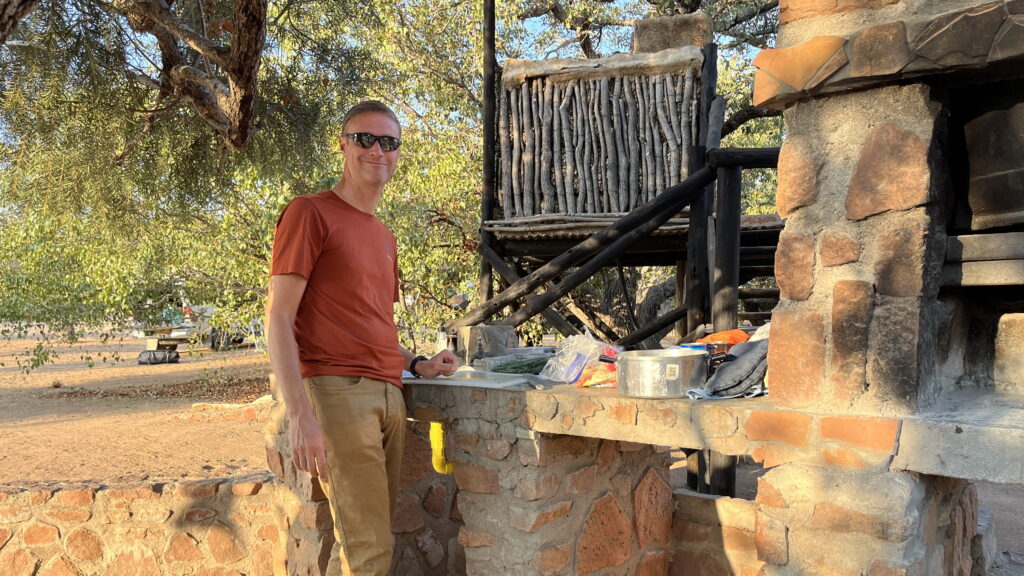
Day 15: Twyfelfontein and Damara Living Museum
We realised that two of the brackets that support the rear tent and connect it to the car, was broken, probably due to vibrations from the rough roads.
We had to fix the broken tent brackets, and asked for help at the camp. The helpful staff found wires we could use for a temporary bush repair. We called the emergency number at Bushlore, and had Mr Joel on the line. After a while he had found a solution: the following day at 9:00 we would pass the town of Khorixas, where a mechanic would be ready for us.
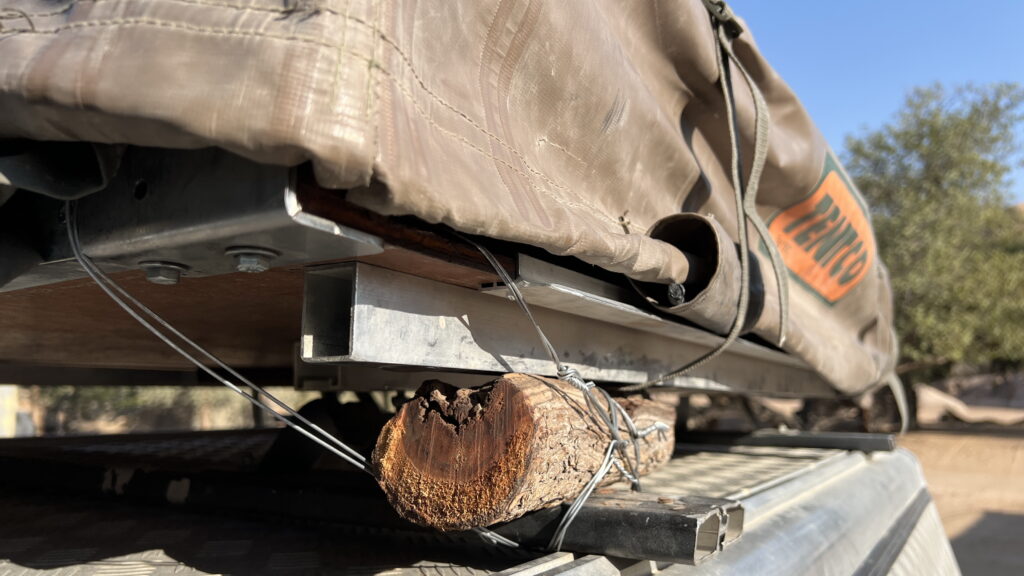
We then visited Twyfelfontein, home to ancient rock engravings that tell stories of the region’s early inhabitants. We had a guided tour by Reinhold, one of the local guides.
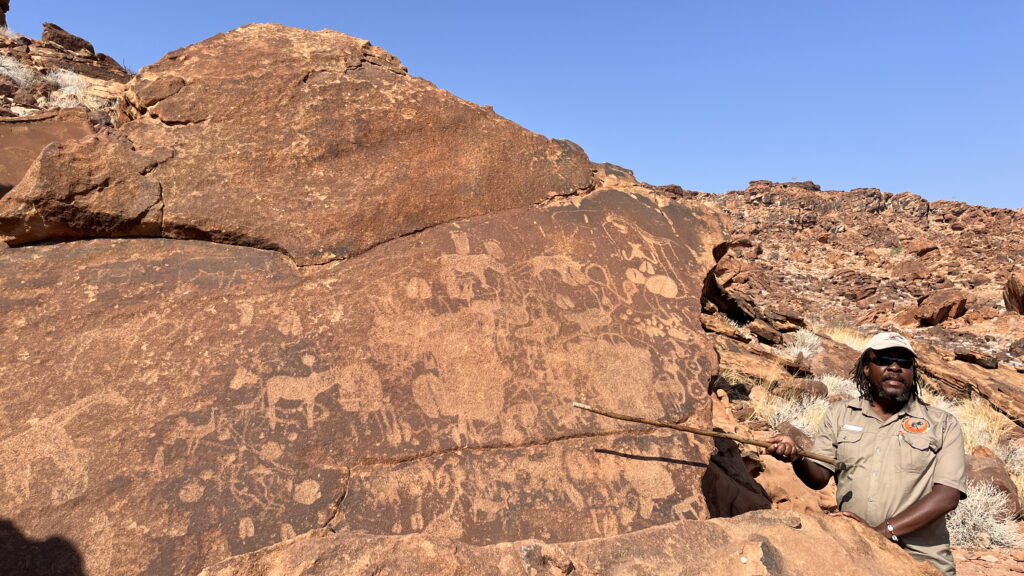
At the nearly Damara Living Museum, we had a tour that introduced us to the traditional lifestyle of the Damara people. The museum is built as a traditional village, but it is not permanently inhabited. But the staff are Damara who live nearby, and are knowledgeable about their history and culture.
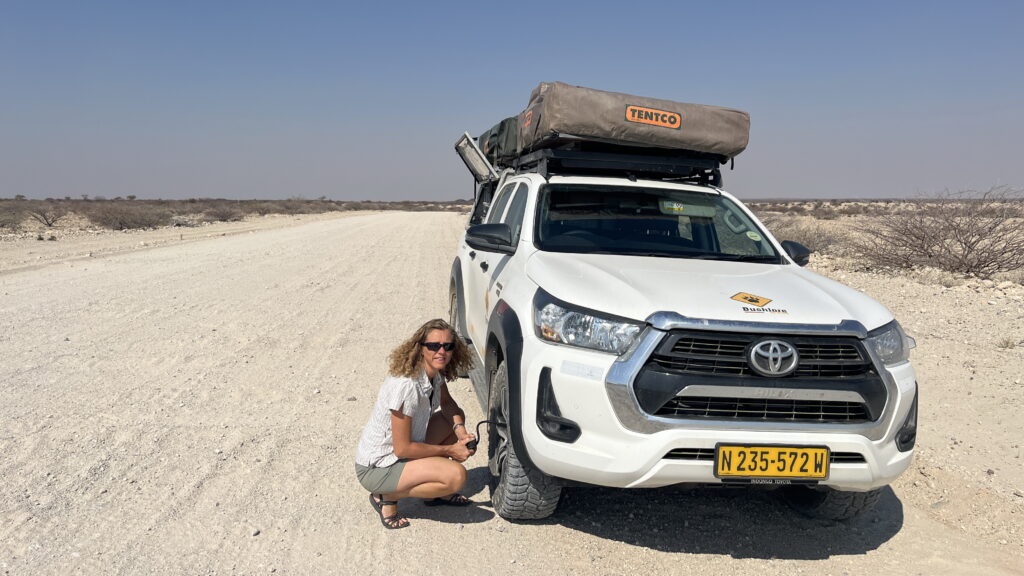
Day 16: Repair in Khorixas and Himba Culture
An early start took us to the workshop in Khorixas, where we arrived at 9:00 as planned. We called Mr Gabriel, the mechanic, who was ready at his workshop with four other people. They had spare brackets, and quickly replaced the broken ones. It was an impressively efficient operation.
With the car ready to continue, we passed through Opuwo, which is the last town before entering Kaokoland in the far north of Namibia. We saw Himba and Herero people dressed in their traditional attire, among people wearing western clothes.
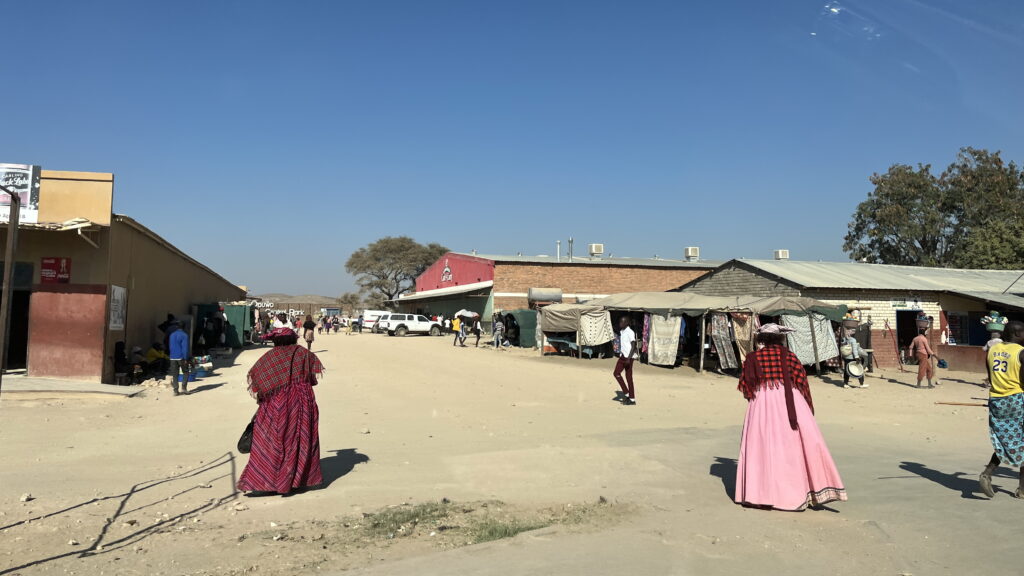
North of Opuwo we checked in at Omungunda Camp. It is owned and operated by local Himba.
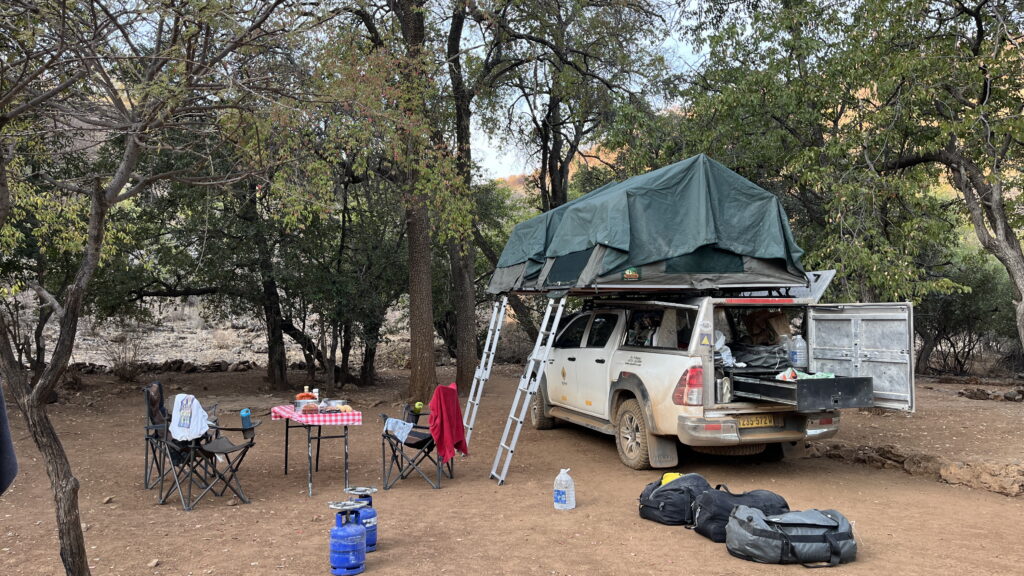
We went for a walk with George, who showed us rock paintings and a thousand-year-old baobab tree.
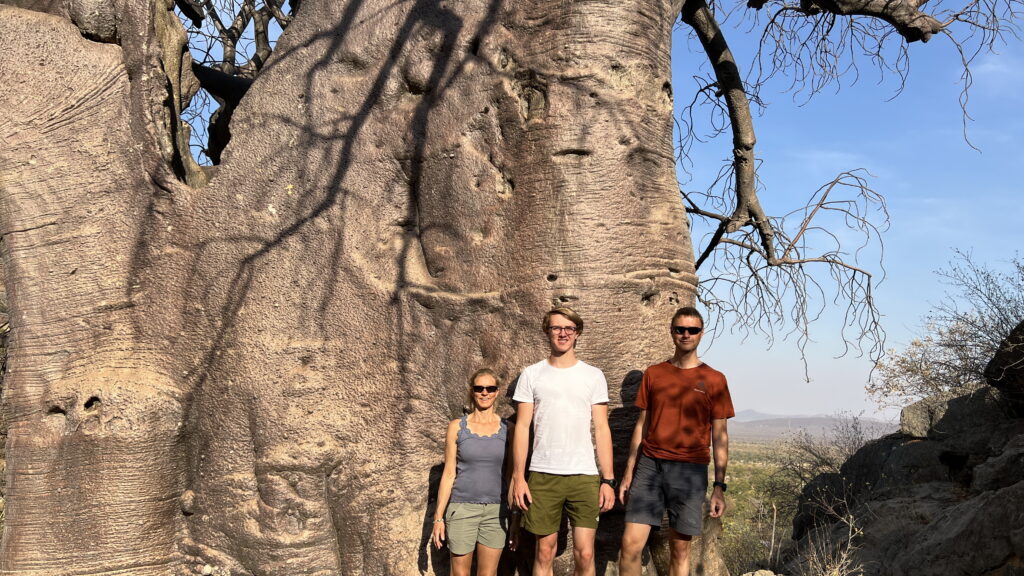
Day 17: Himba Village and Epupa Falls
In connection to Omungunda camp is the Ovahimba living museum, which is a village where Himba still live their traditional lives. They invite visitors as a way of preserving their culture. The visit offered a glimpse into their daily life and cultural practices.
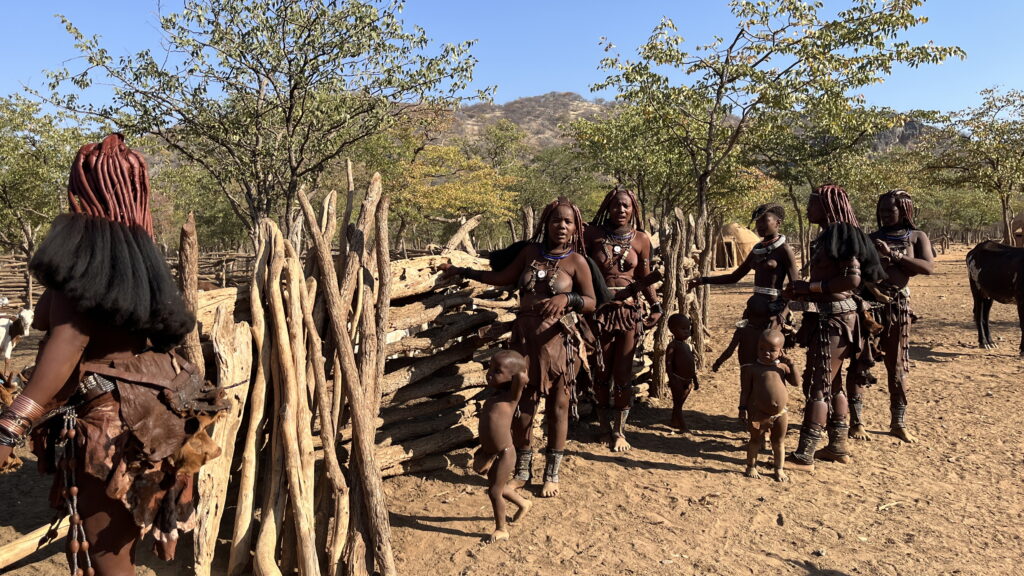
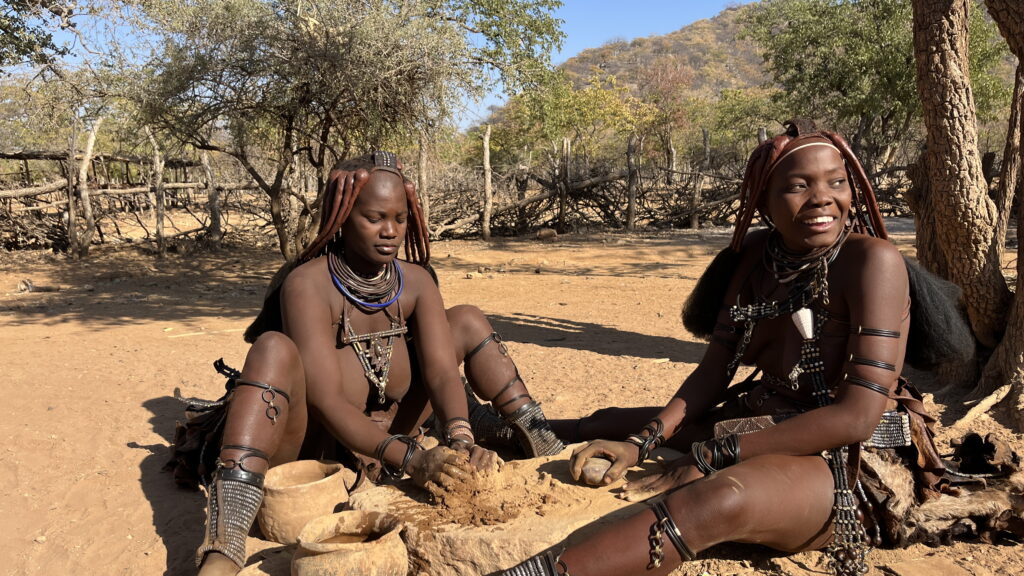
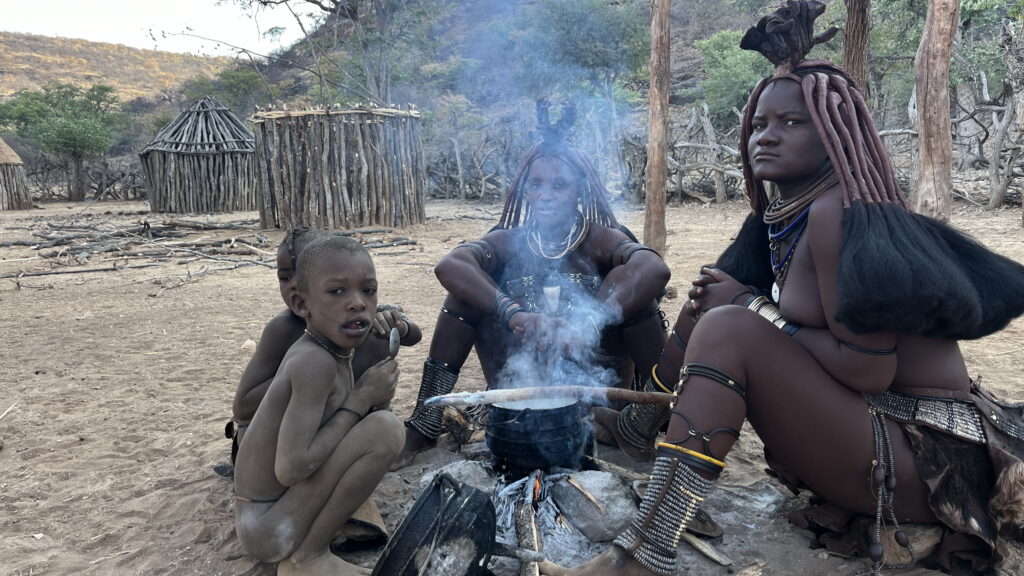
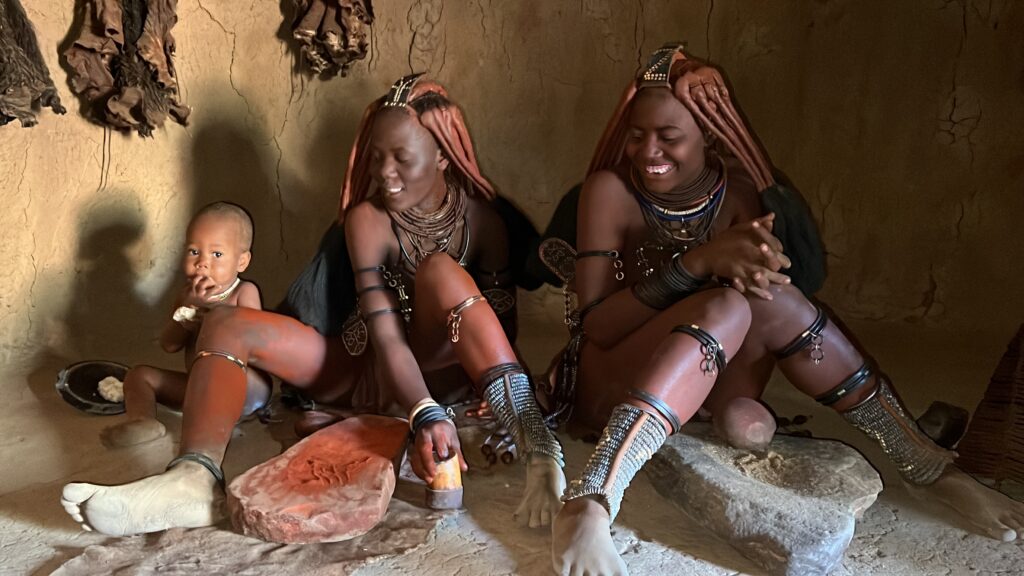
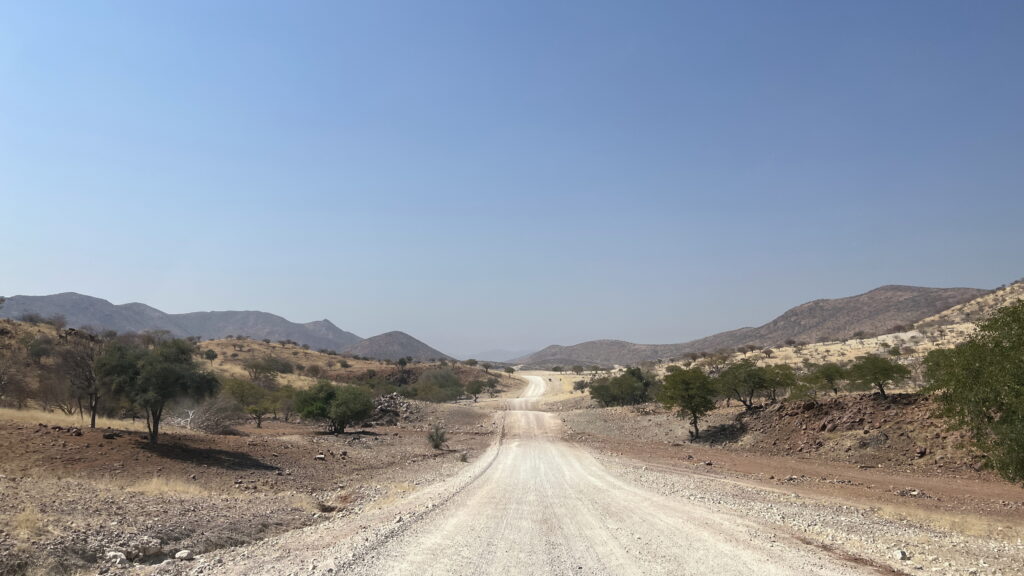
From Omungunda camp, we drove to Epupa Falls, a lush oasis on the Kuene River. We checked in at Epupa camp, and went on a sunset tour of the falls. It is an impressive sight with the cascades framed by the vibrant greenery of the riverbanks. Just a few hundred metres away from the river, the landscape turns arid.
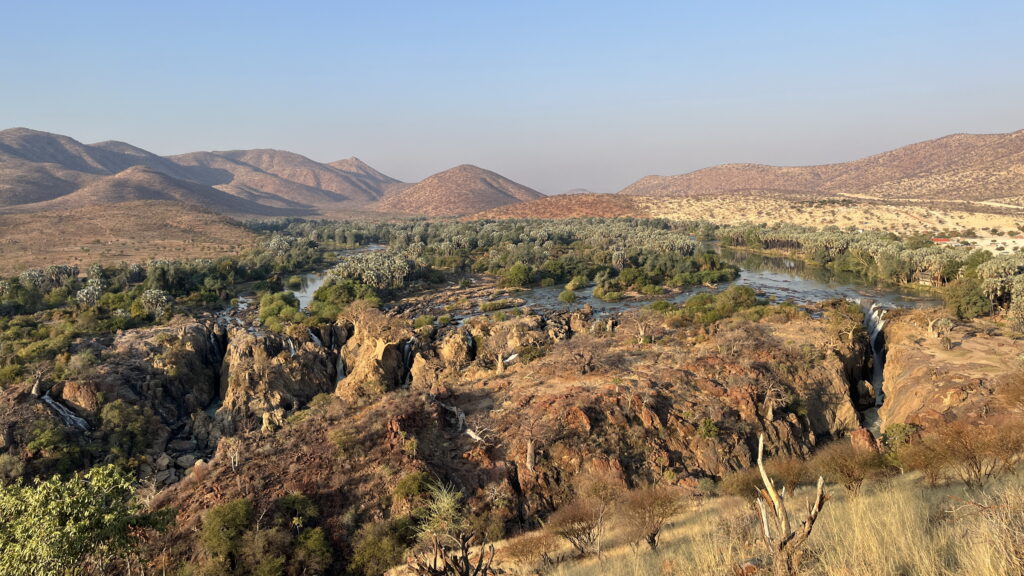
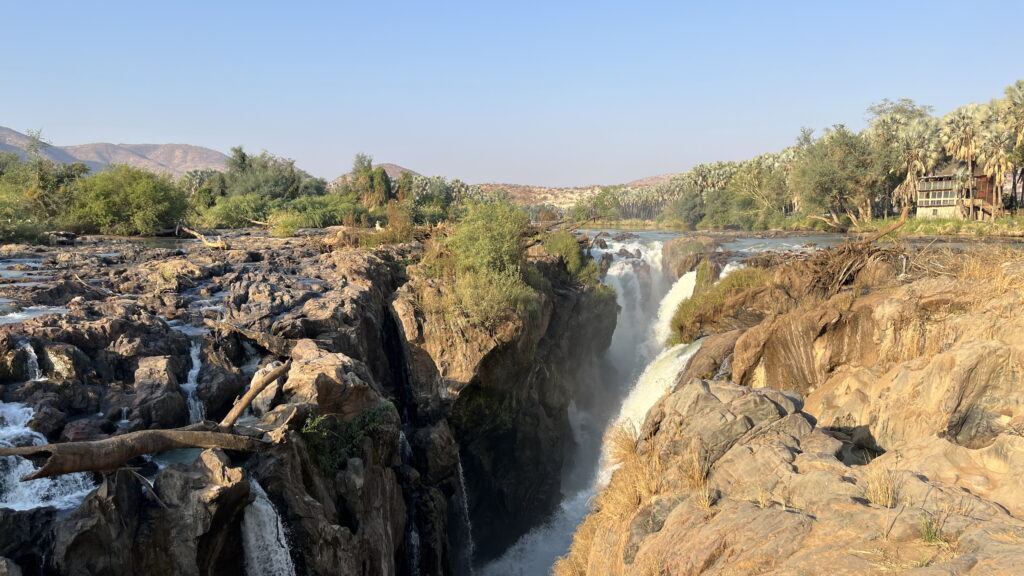
We were treated with a sundowner – drinks and snacks – as we watched the sun set. A memorable experience.
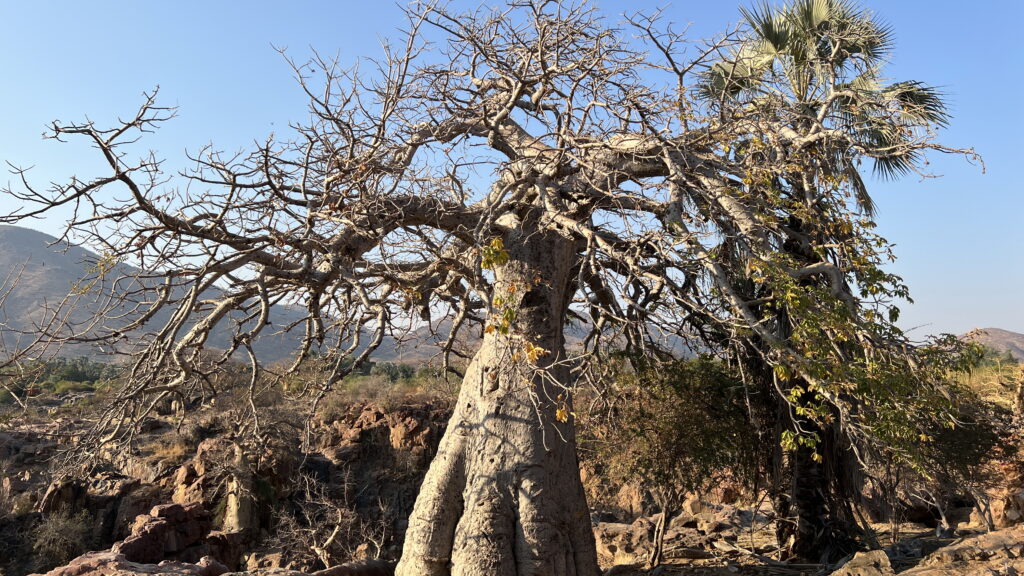
There are palm trees by the river, and also at Epupa falls camp. T set up his hammock between the palms. We made dinner by the river, with a view across to Angola.
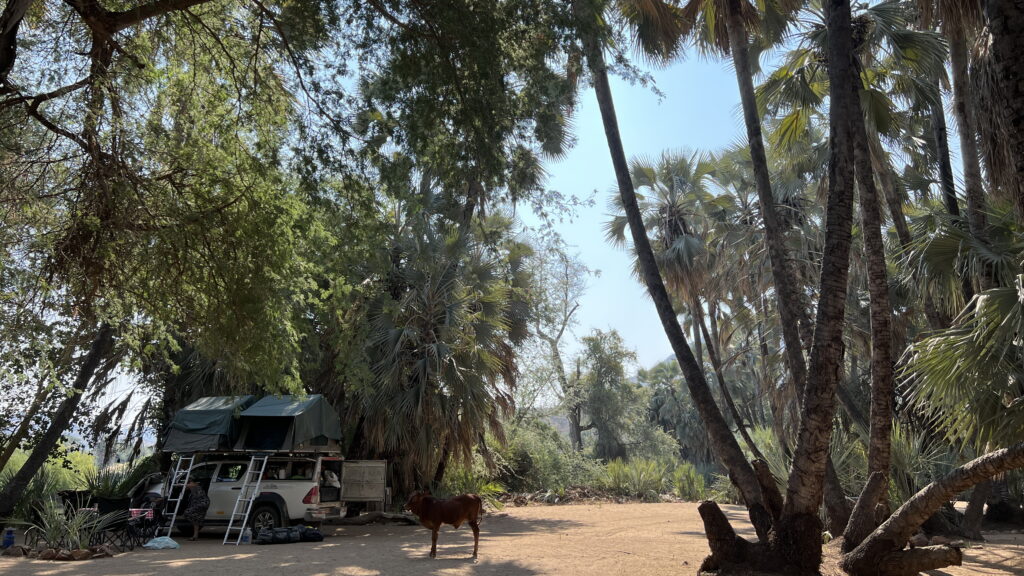
Day 18: Rafting and Crossing into Angola
Epupa falls camp is the only camp that arranged rafting on the Kuene river. We had arranged a morning rafting tour, and met with the guide at the camp. We drove approx 15 km upstream towards Ruacana, where we started paddling back towards the camp and the water falls.
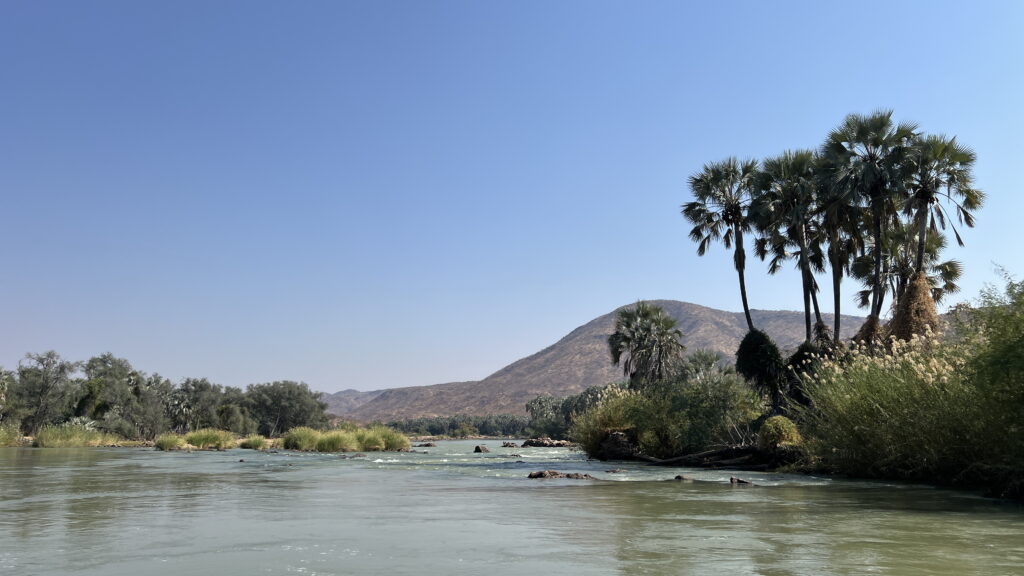
There are signs by the river warning you not to swim, because there are Nile crocodiles in the river. They grow up to 5 metres long, and we were hoping to see some.
The river was very calm. We hardly got wet, and it would be an exaggeration to talk about “rapids”.
We met many crocodiles, and could paddle quite close to them.
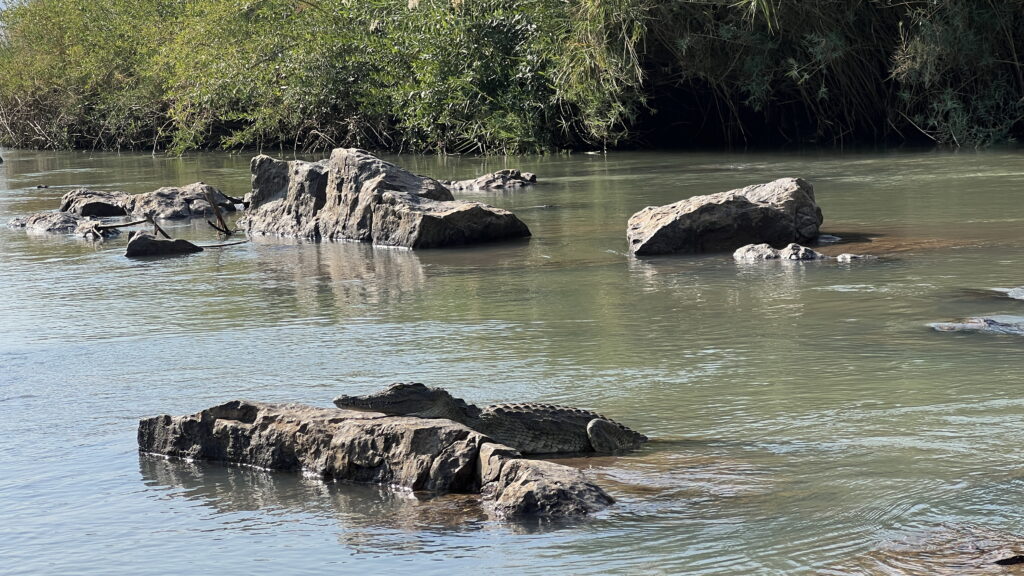
Along the river there are palm trees and a tropical atmosphere. It is Namibia to the left and Angola on the right. We passed a small island in the river, that belongs to Angola, and here we made a stop. The guides had brought soft drinks, so of course we should have a “cola in Angola”!
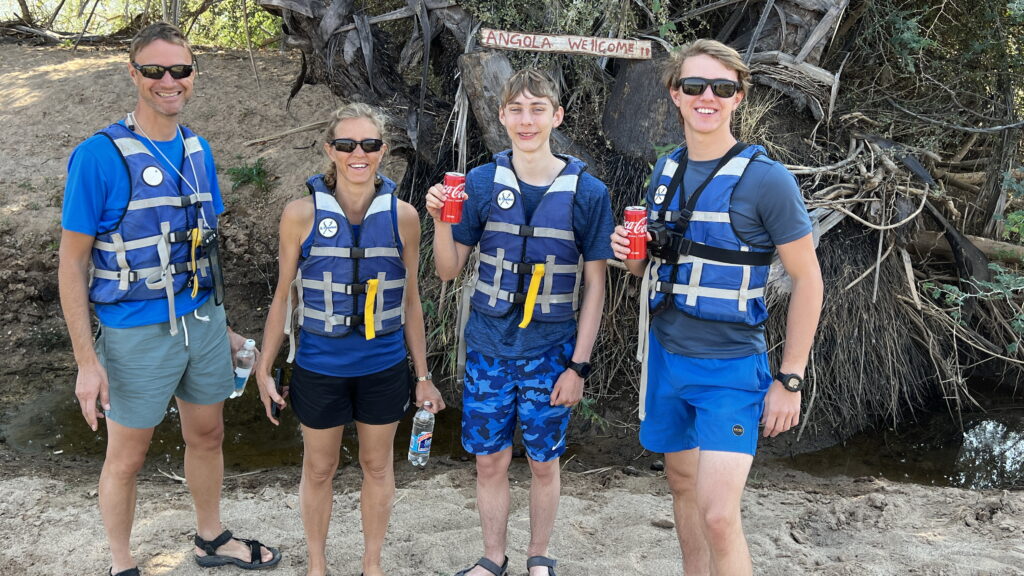
We left Epupa and drove south towards Opuwo, where we spent the night at Opuwo Country Lodge, enjoying the pool and another stunning sunset.
Day 19-22 Etosha National Park
From Opuwo we continued south, and entered Etosha National Park through the western entrance at Galton Gate. It is less used then the south and east gates, and we met very few other cars. Etosha is home to the big five, and many other iconic African species. The animals roam freely within the fenced park. As a tourist, you can drive on the roads yourself, and go searching for the best places to spot wildlife.
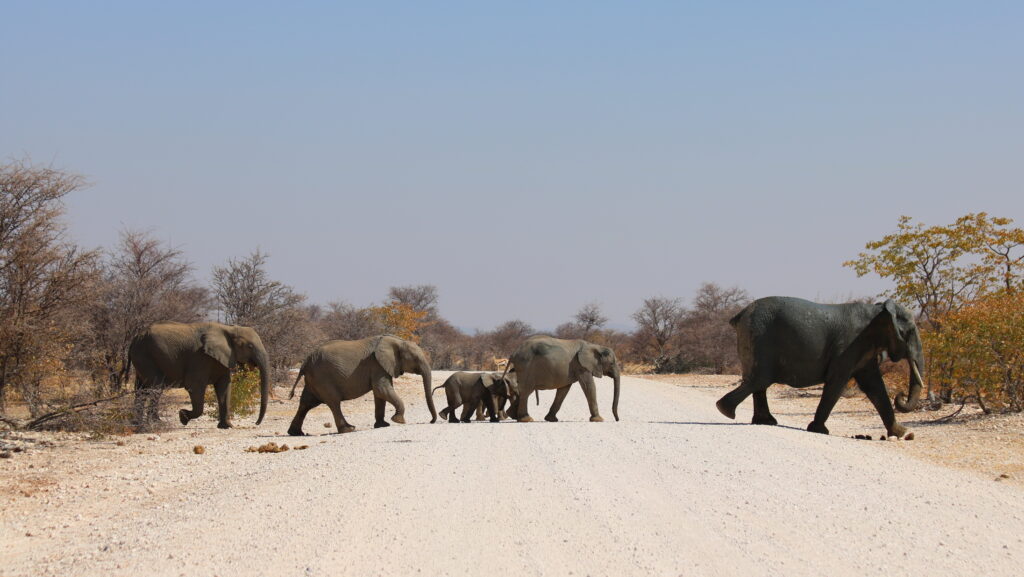
Right after entering the park, we saw mountain zebras, a rare sighting. We continued towards the Okaukuejo campsite. Etosha is dry, but with waterholes where the animals come to drink. It is possible to drive near to many of the waterholes. Most people visit Etosha by driving between the waterholes, to try their luck.
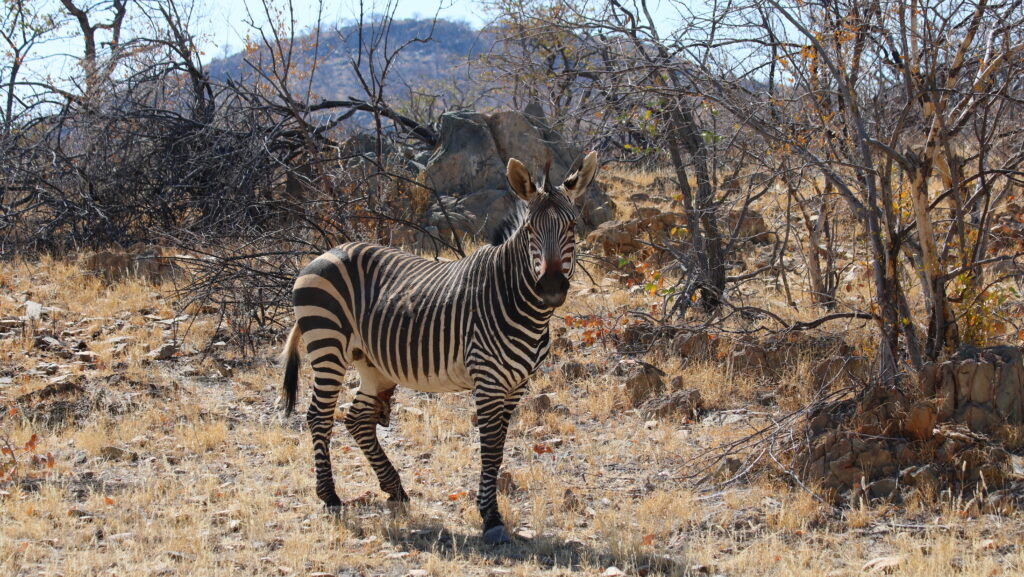
It seemed there were elephants, giraffes, springbok, oryx, zebras, red hartebeast, kudu, ostrich everywhere.
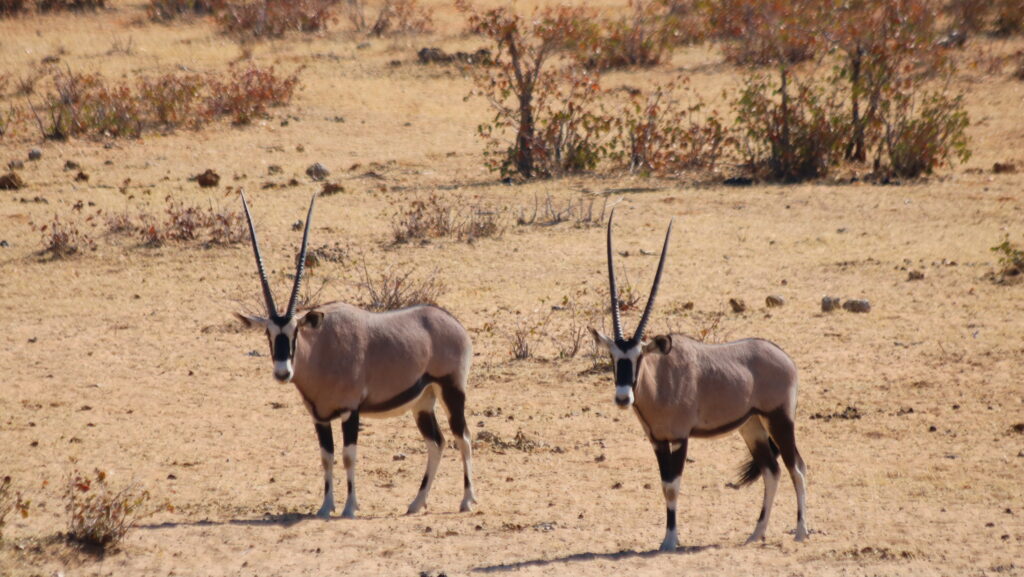
We had two nights at Okaukuejo, and spent the evenings at the floodlit waterhole their. Elephants and rhinos were the primary visitors.
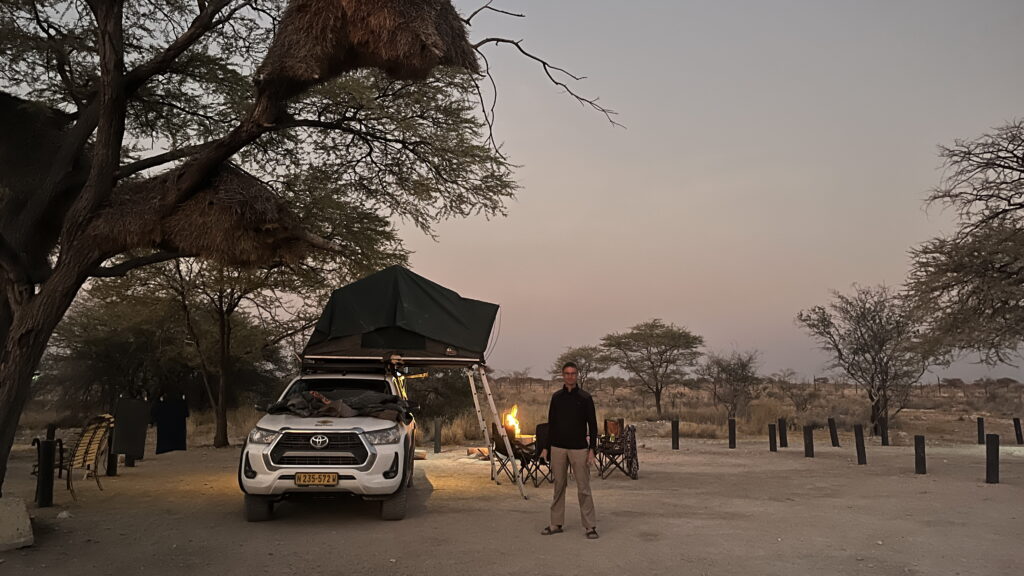
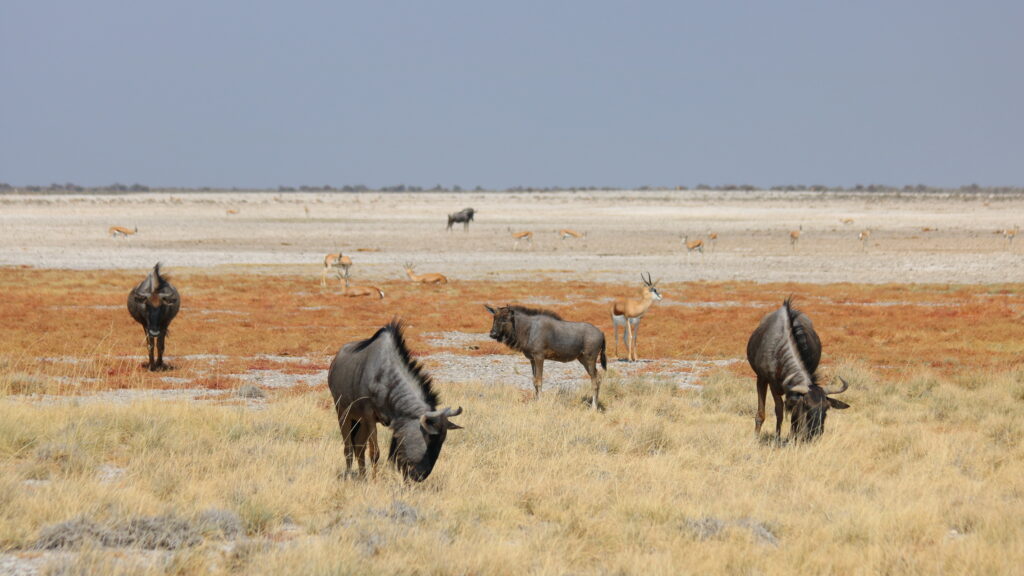
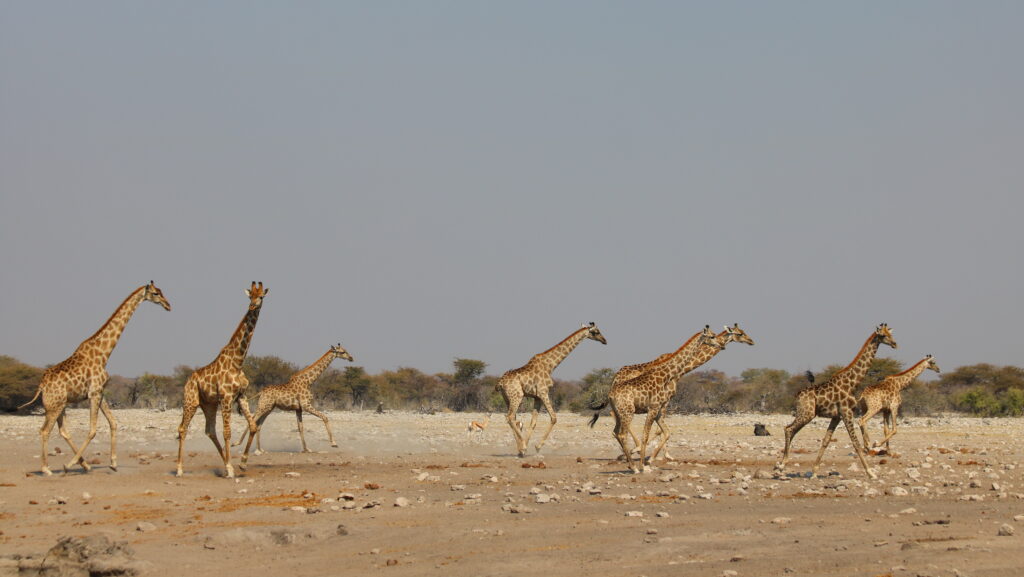
Further east we had two night at Halali. At Halali we went with the rangers on a game drive. The rangers are very experienced in spotting animals, and they use the radio to share sightings with each other. We hoped to see some of the rare predators (lions, cheetah and leopards), but were not that lucky.
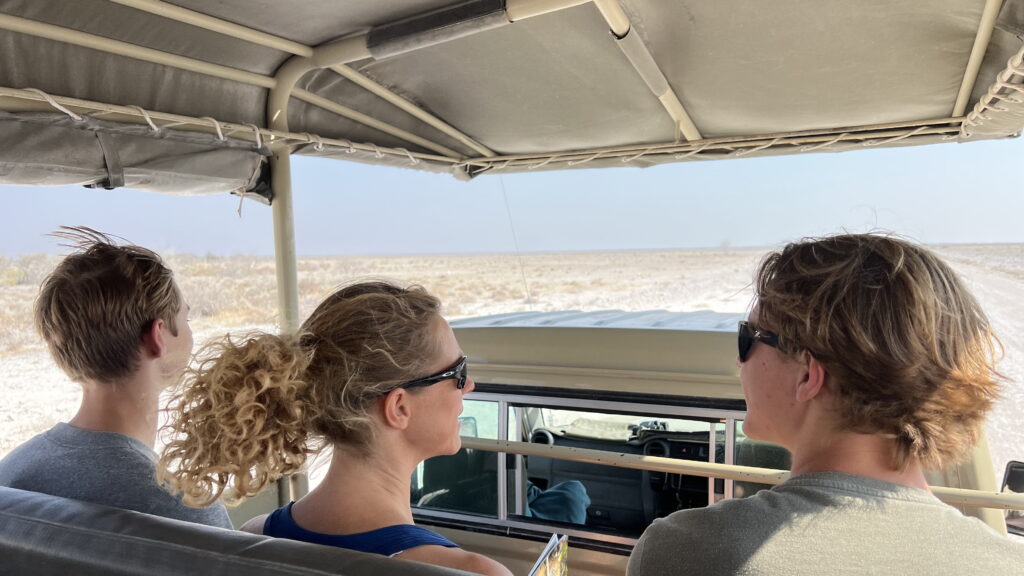
The next day, we were lucky to spot lions at a waterhole in the morning at one of our own drives. We also saw white (or more correctly “wide”) rhinos and honey badgers.
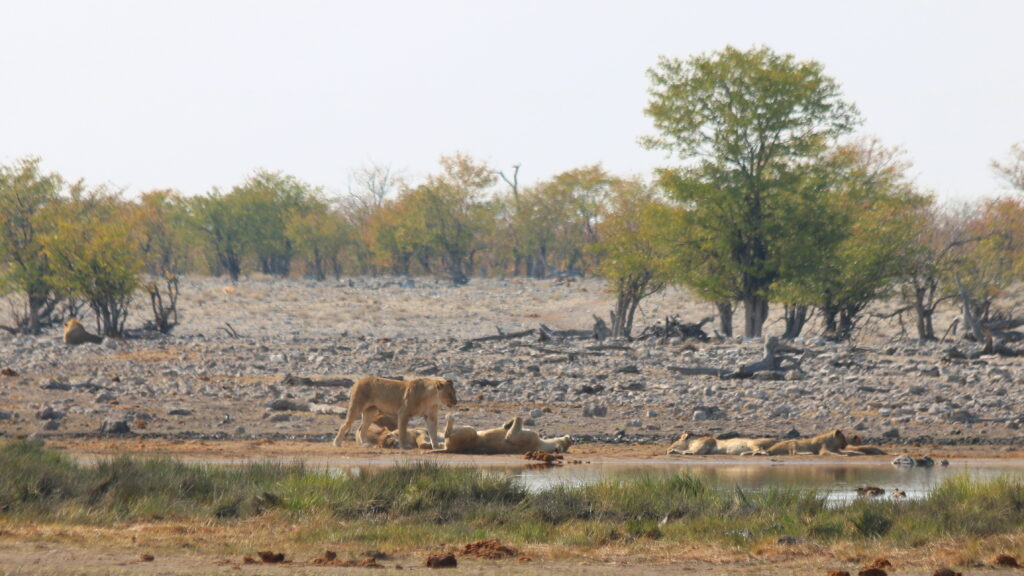
On one of the last days, we noticed that two of the three bolts that held the spare wheel in place at the rear of the car had broken off due to vibrations while driving. Again we contacted Mr Joel, and explained that we hoped to be able to leave camp by 8 the next morning. He arranged a mechanic that came to our car at the campsite at 7:00 exact the next morning. Equipped with an angle grinder and welding equipment he replaced the two bolts. We felt a bit sorry for the families at the next campsite, who seemed to not have planned to get up that early. Also based on the fact, that they clearly had stayed up late in high spirits the previous night.
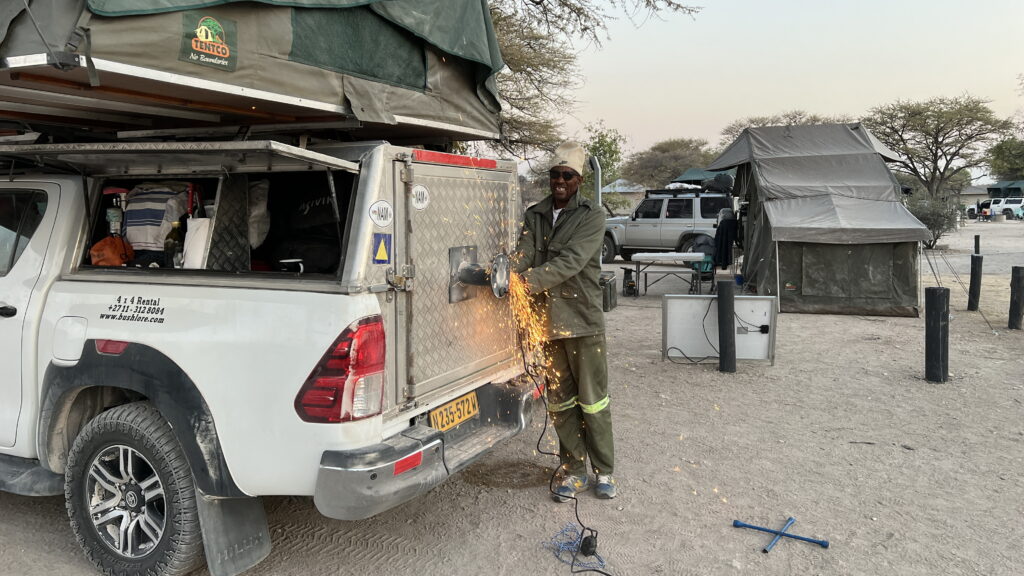
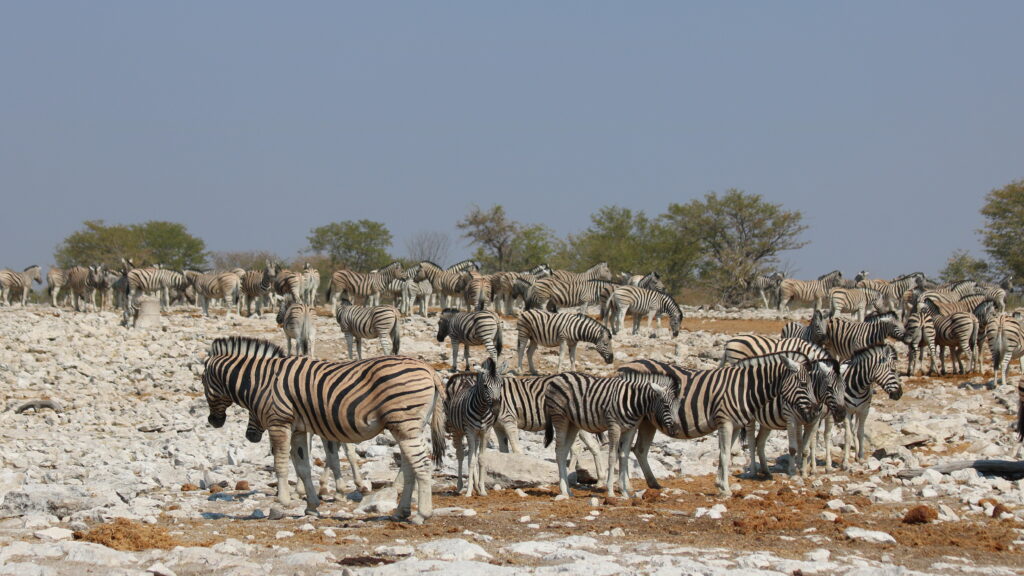
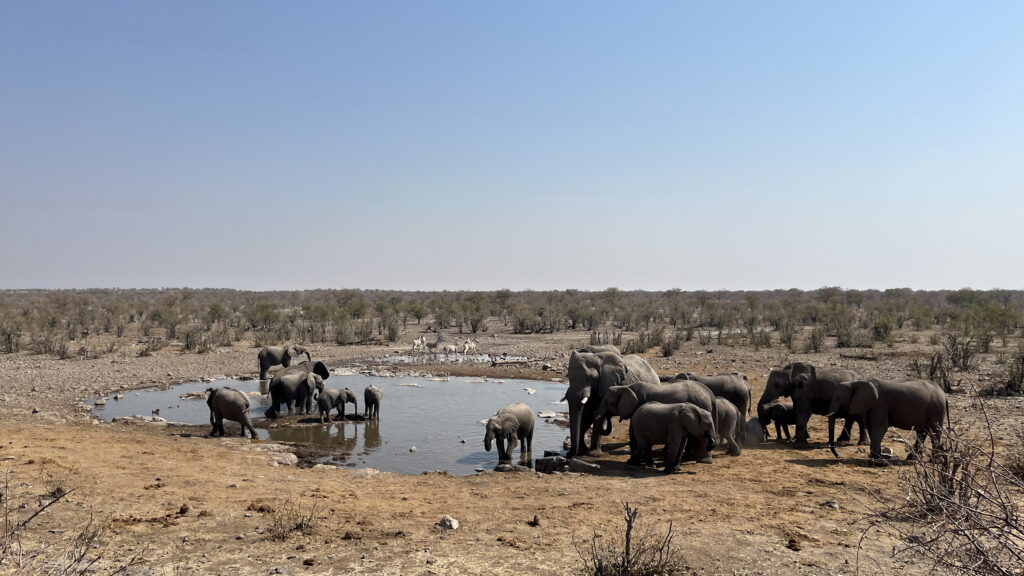
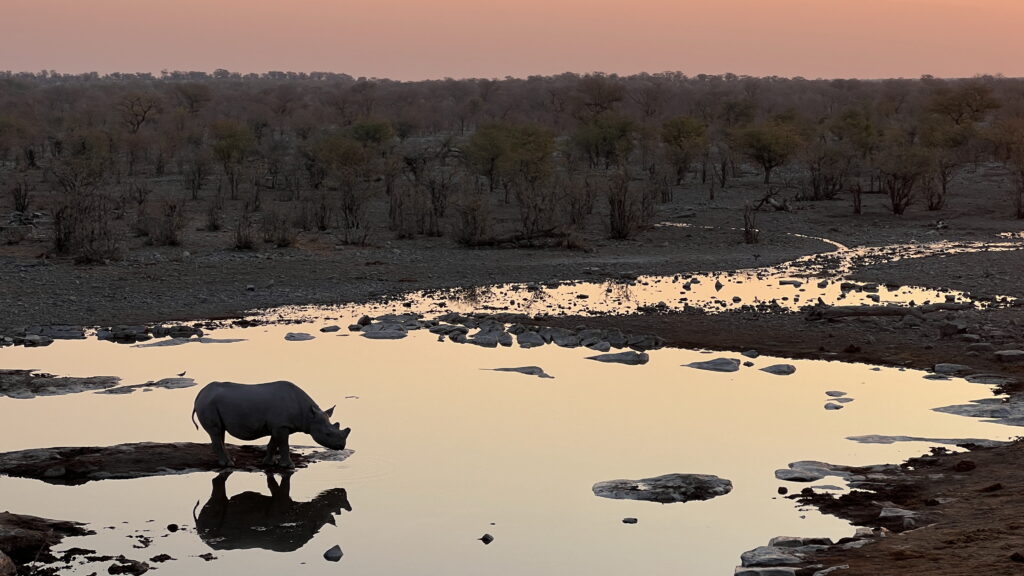
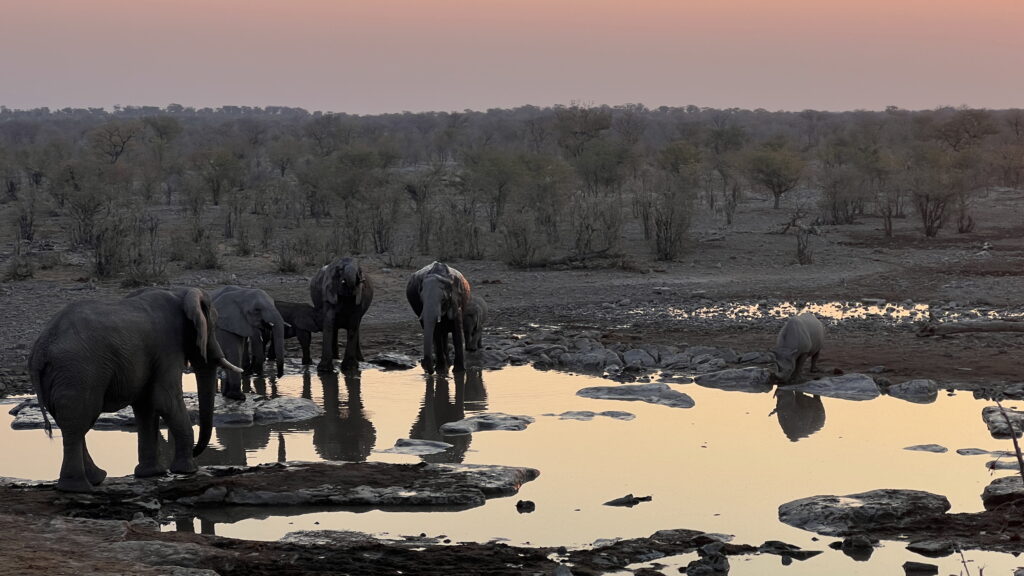
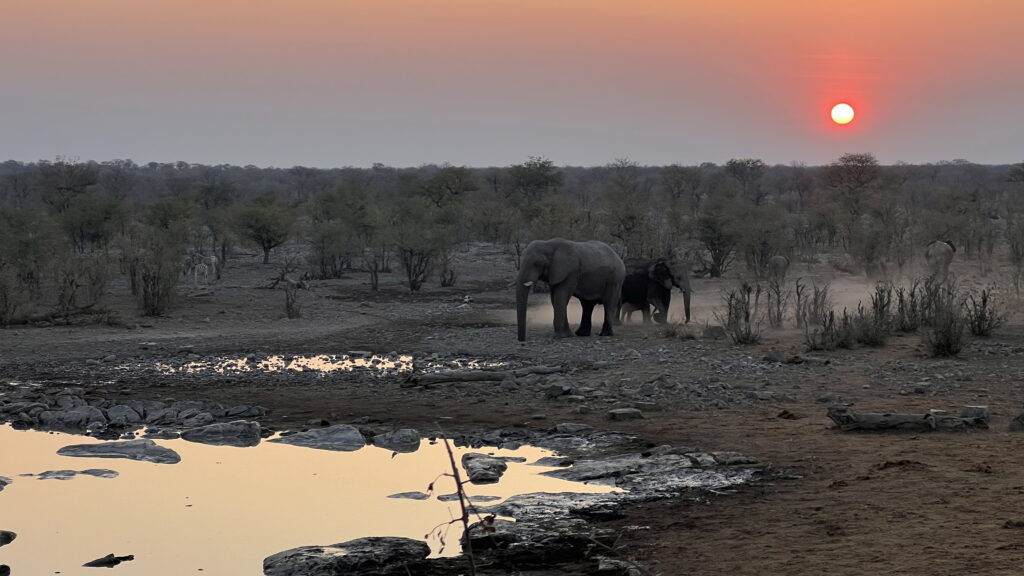
Day 23: Final Day
On our last full day, we began our journey back towards Windhoek, spending the night at Otjibamba Lodge. Wildlife roamed the premises of the lodge, so from the pool we watched giraffes, sable antelopes, ostriches, and impalas.
Southern Africa is a diverse region. On a previous trip we made a road trip through north South Africa.
